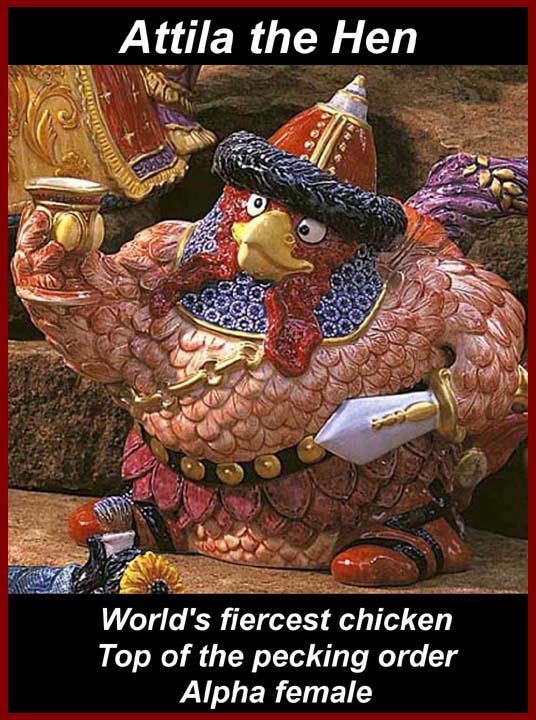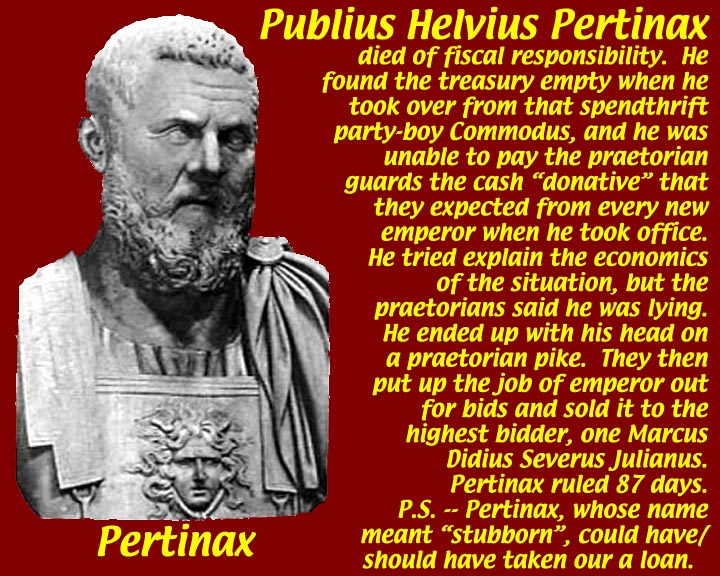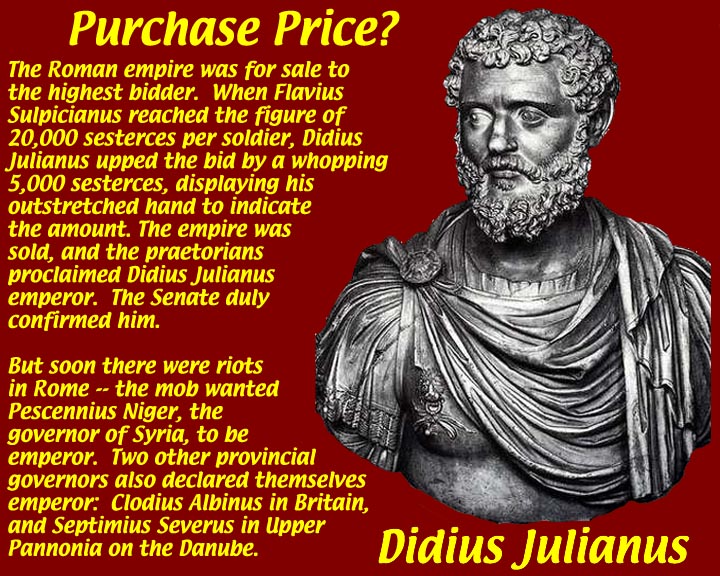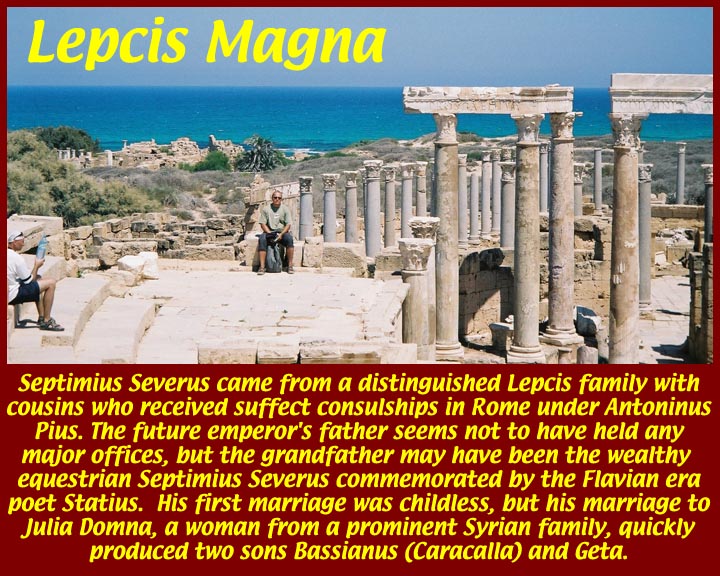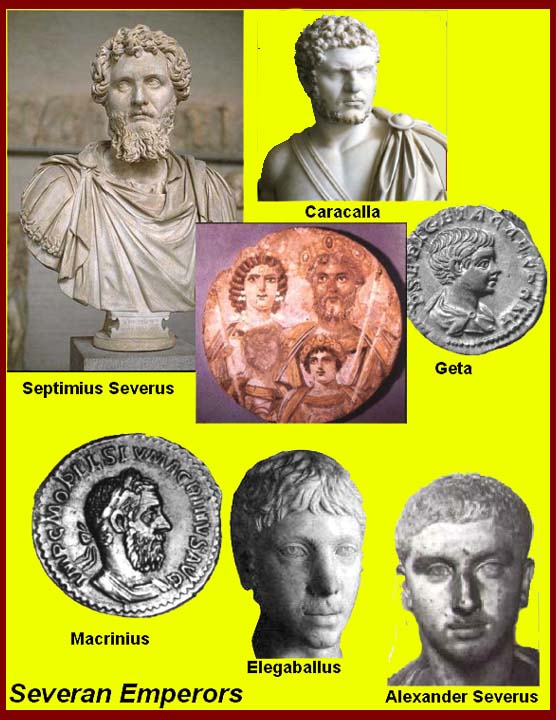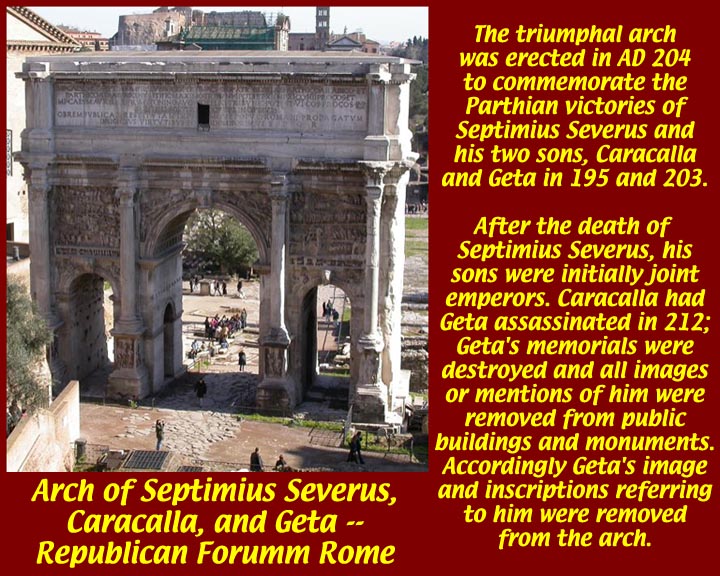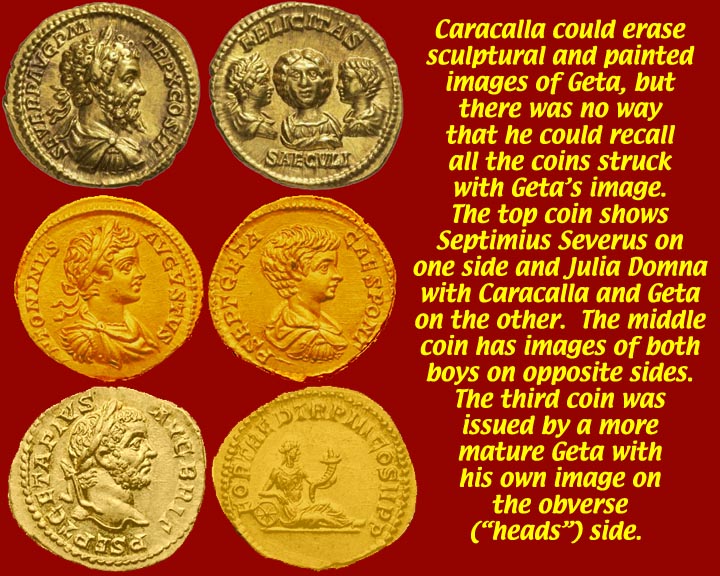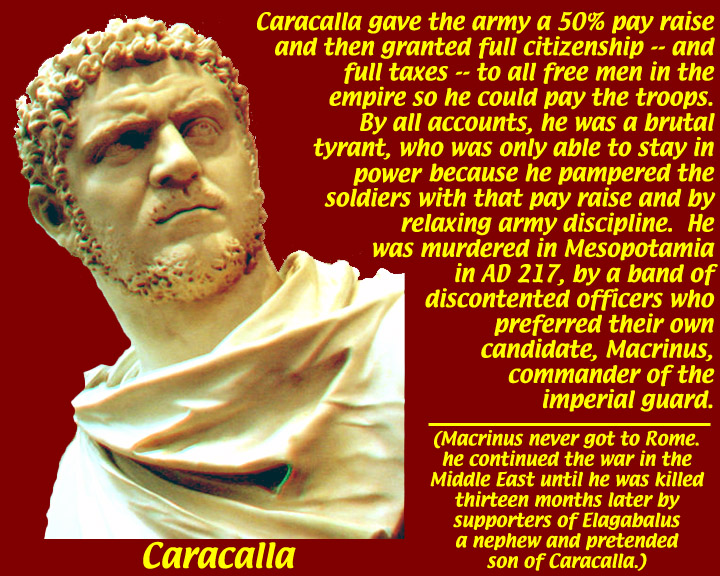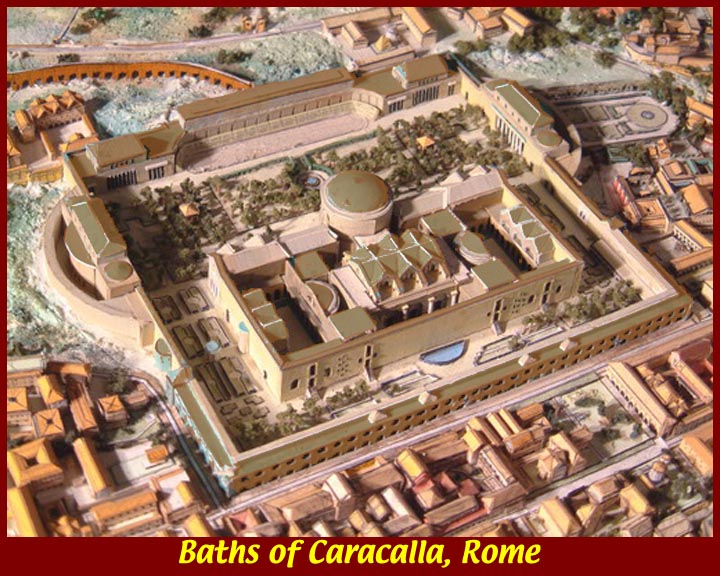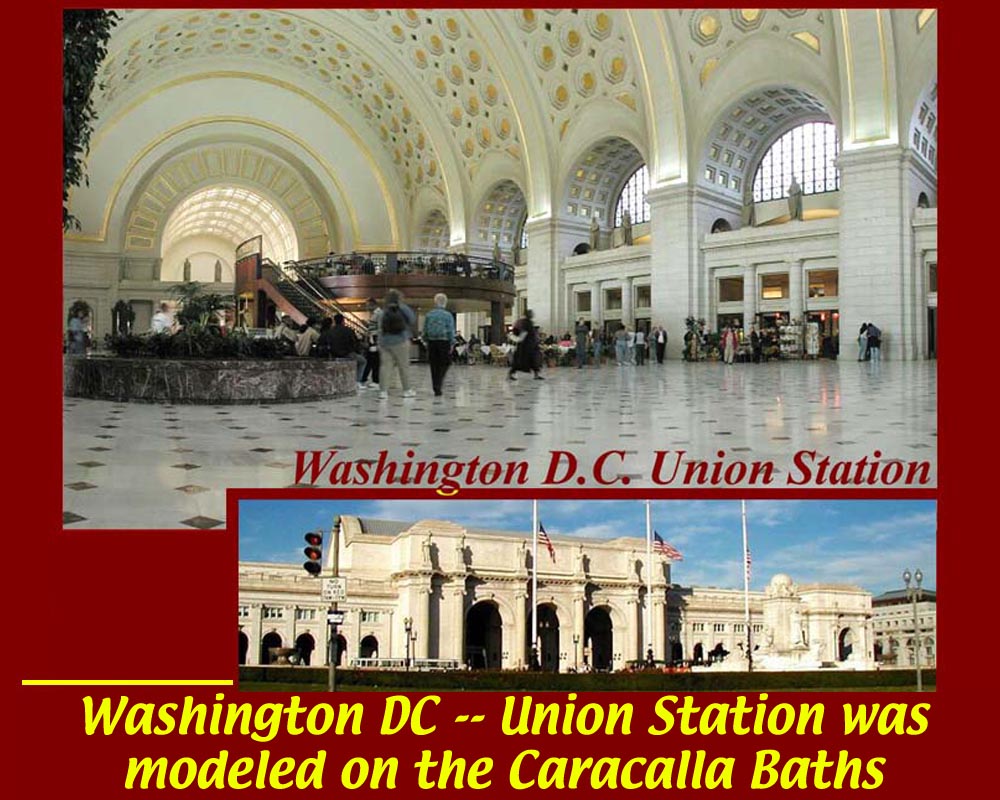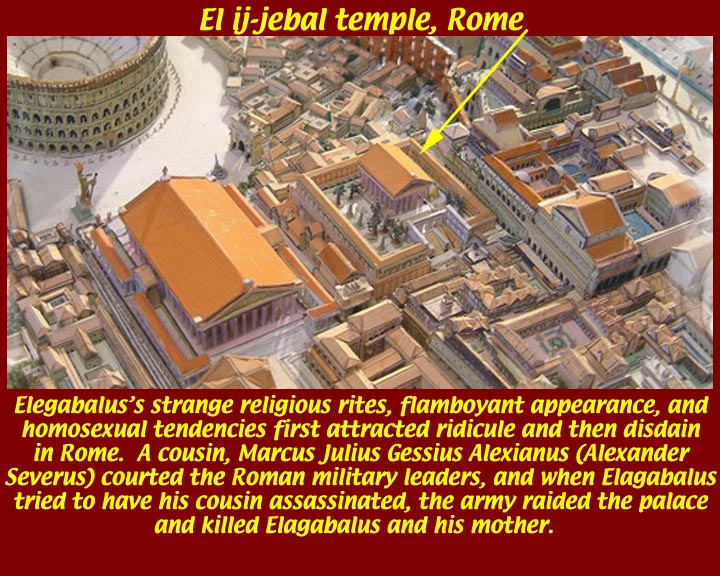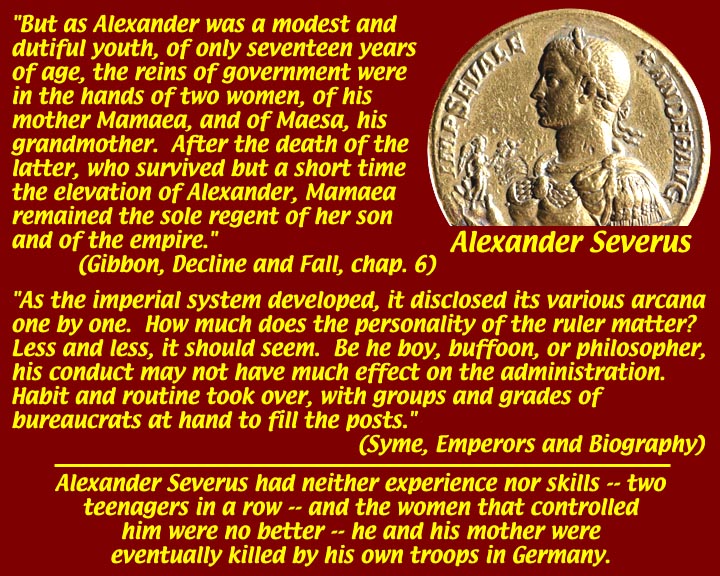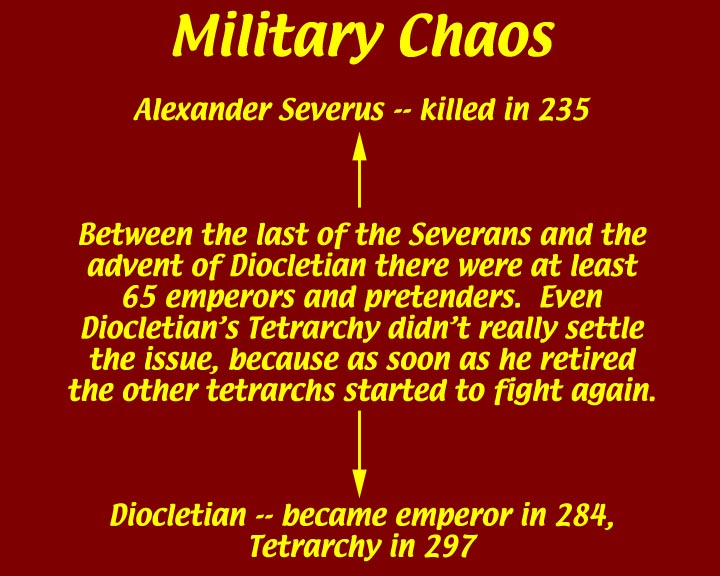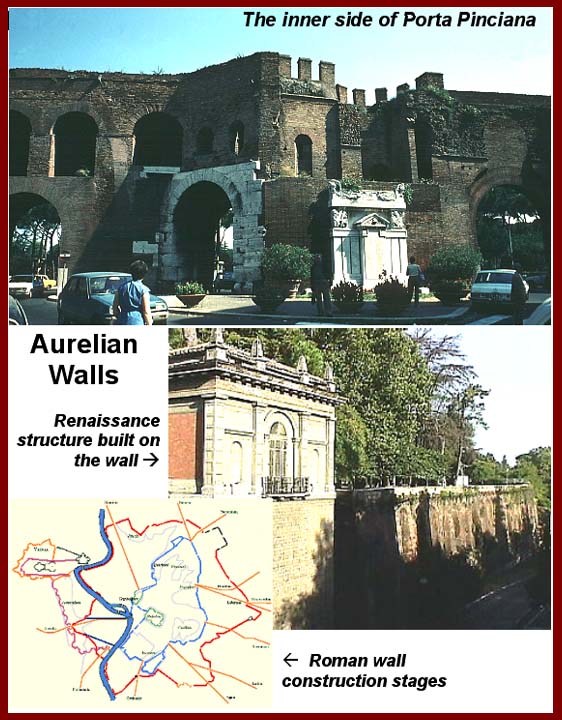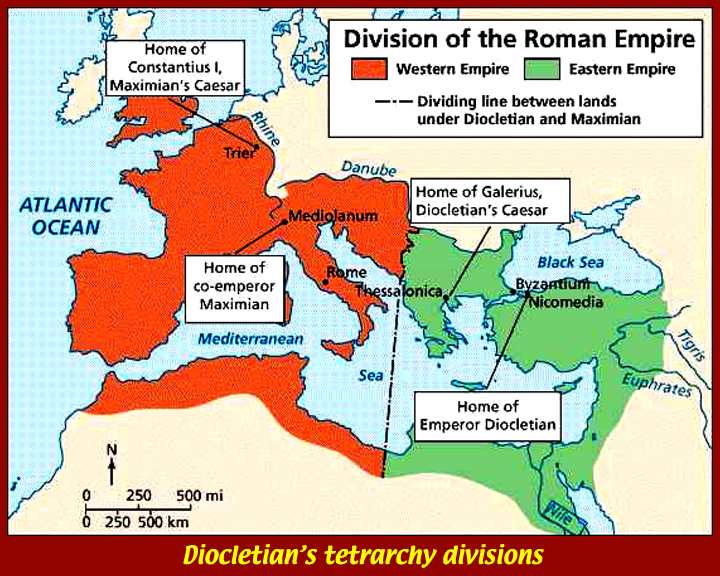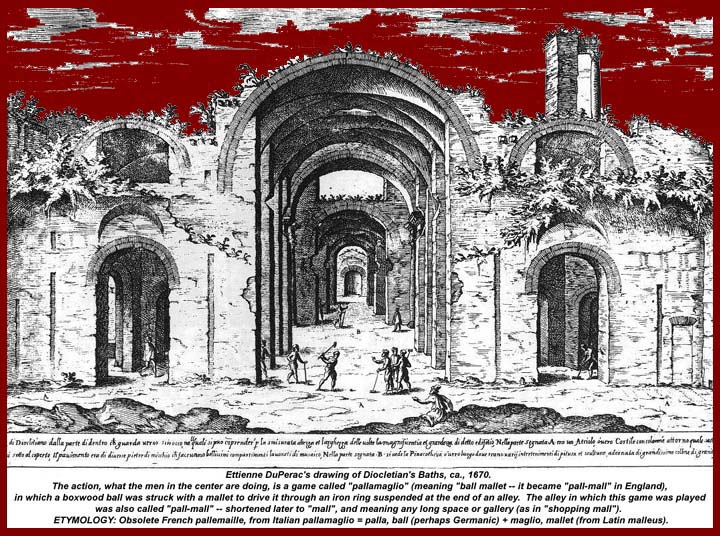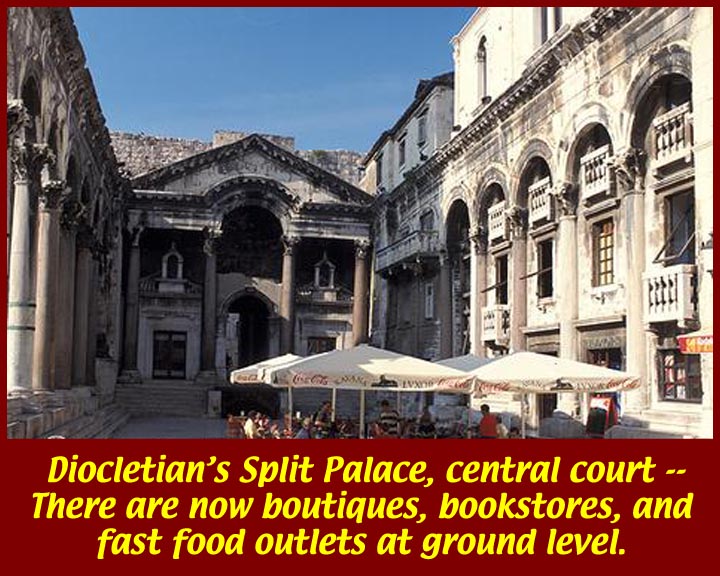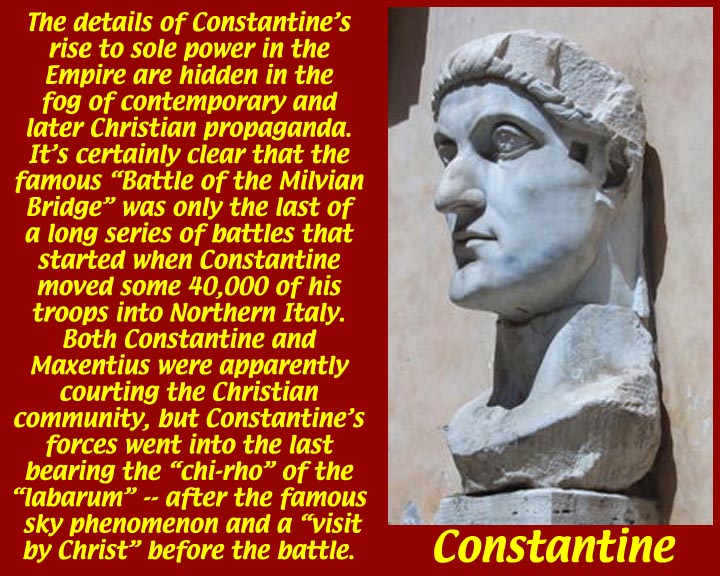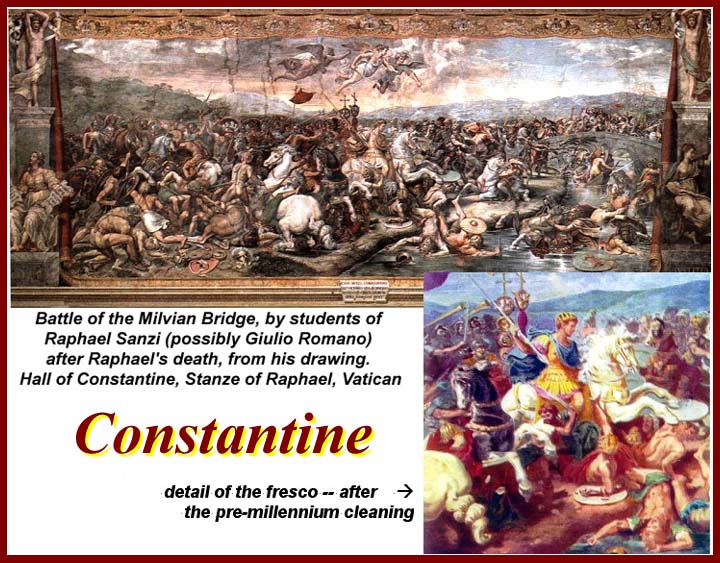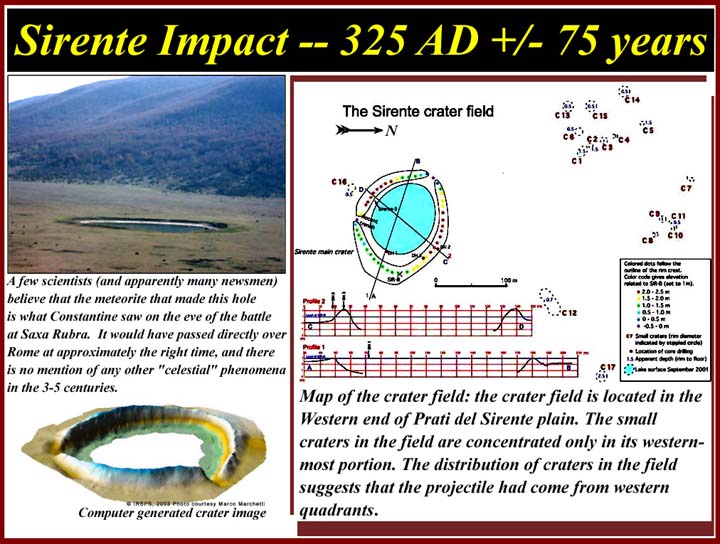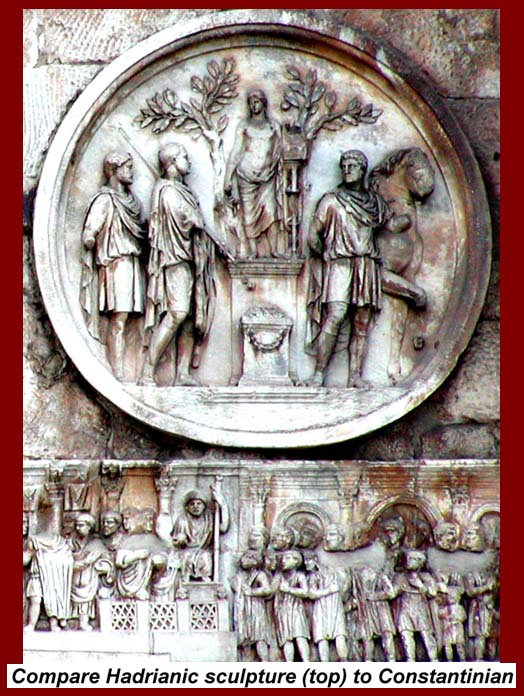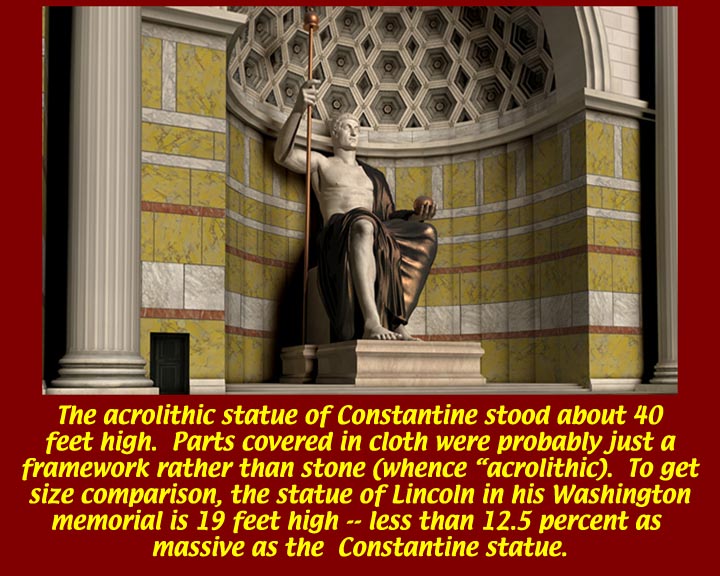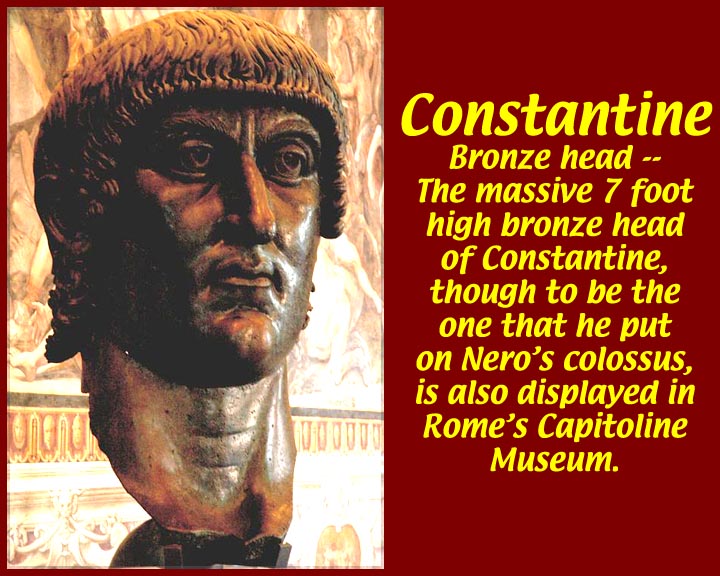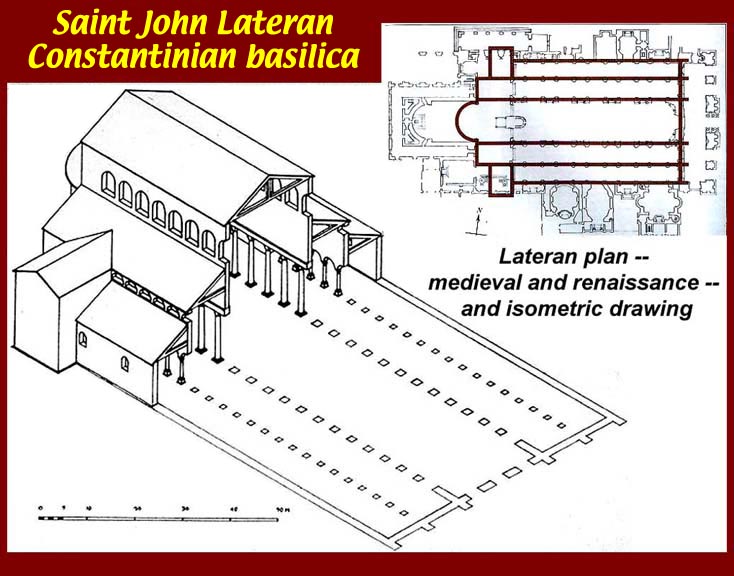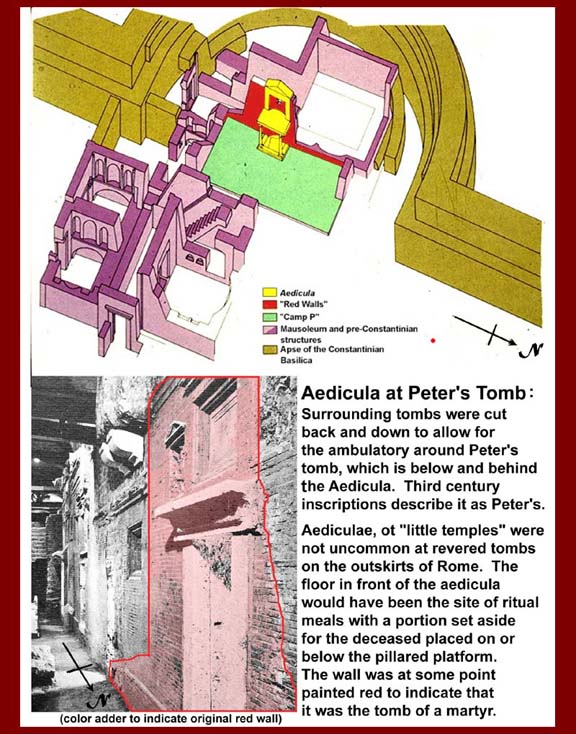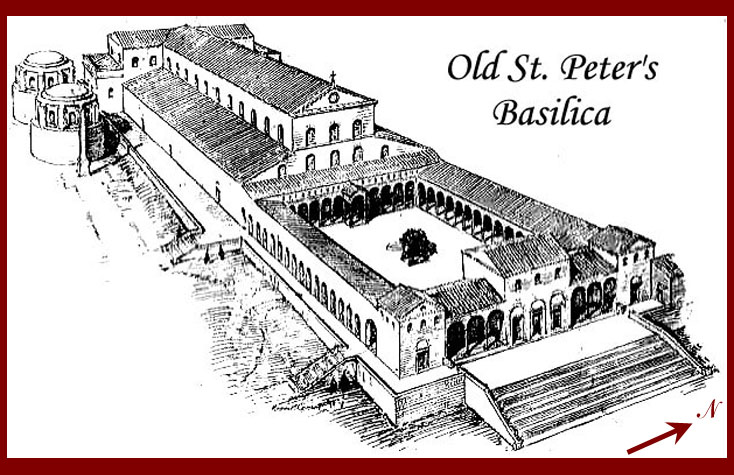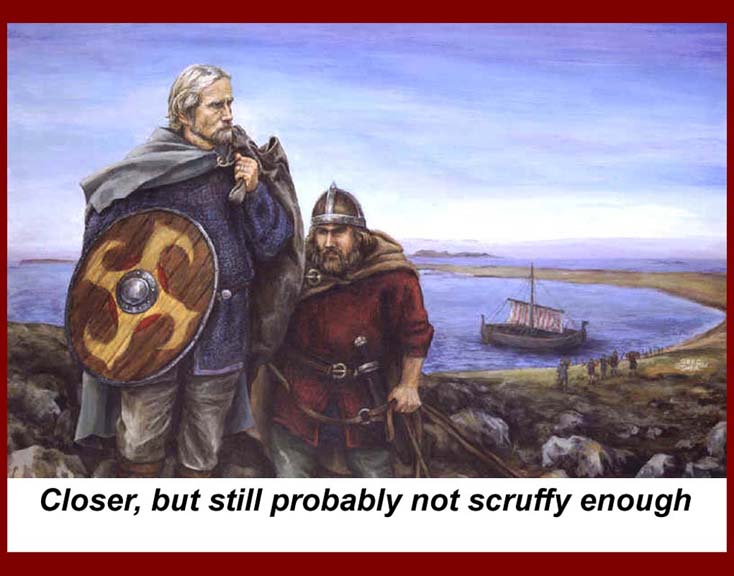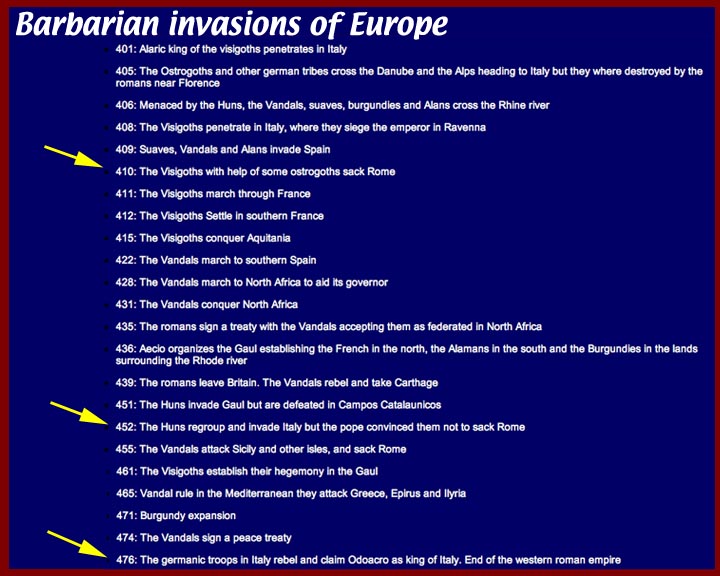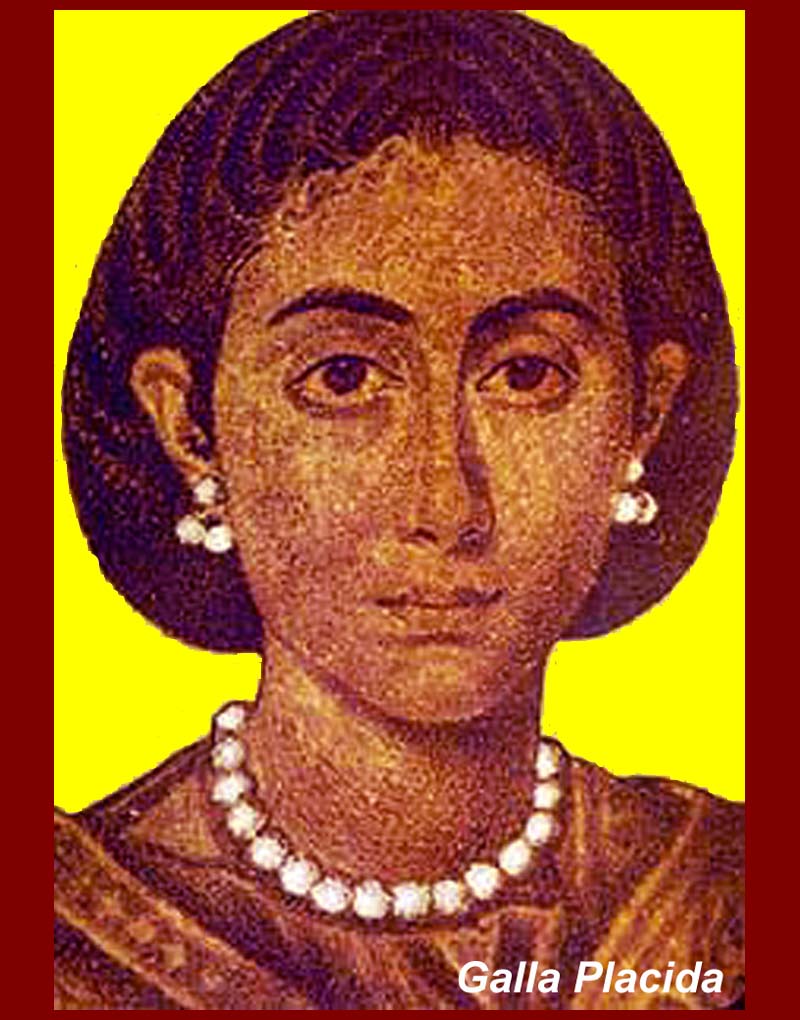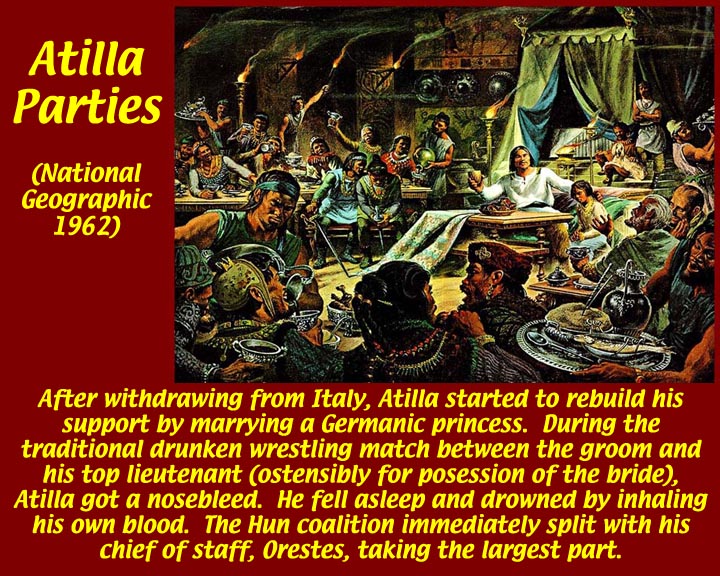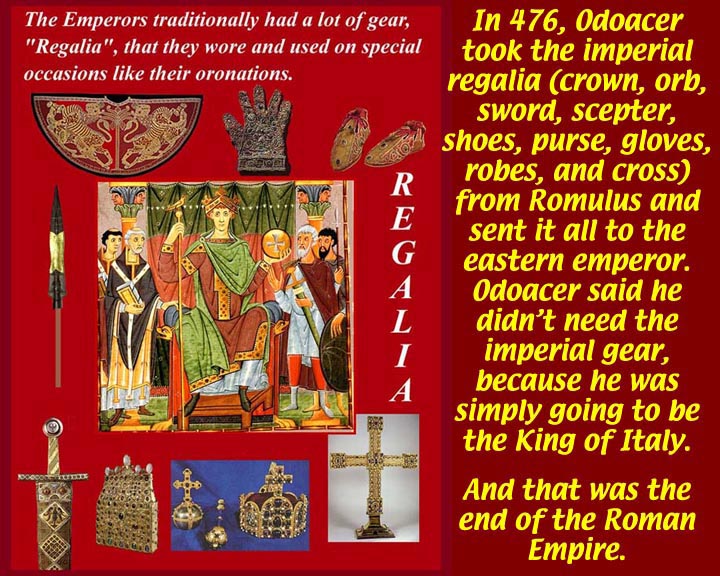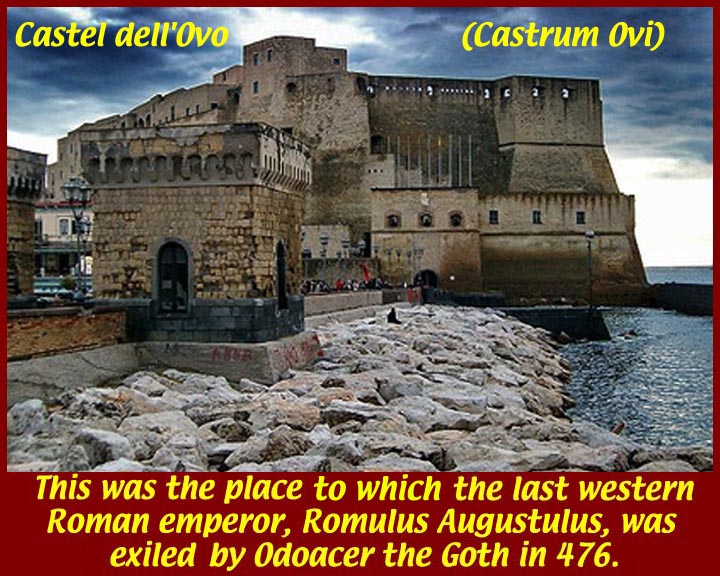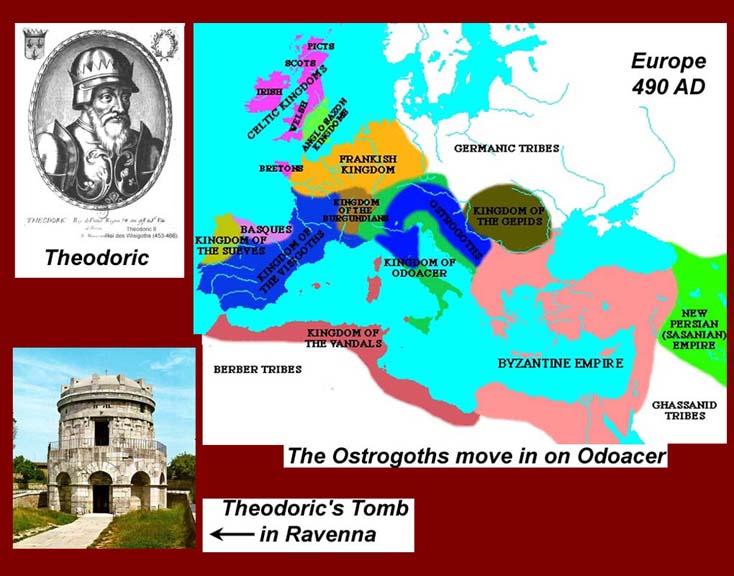Images for ALRI Ancient Rome Unit 8
The Long DeclineClick on links or small images below to see larger images.
http://www.mmdtkw.org/AU0801AttilaTheHen.jpg
In this unit we will see how the Romans weakened themselves to the point that they were easy prey to the barbarians.
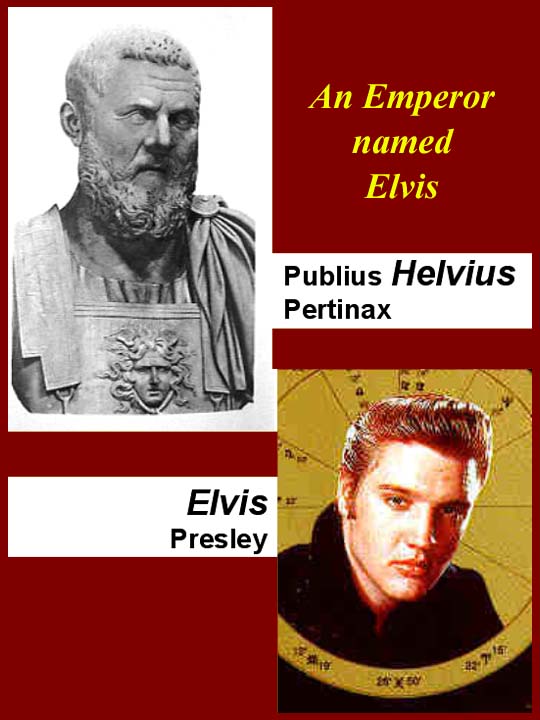
http://www.mmdtkw.org/AU0802aPertinaxElvis.jpg
http://www.mmdtkw.org/AU0802bDeadPertinax.jpg
Publius Helvius Pertinax was a freedman's son and a former school teacher who had worked his way first into the bureaucracy and then into the cursus honorum. He appears to have had some (unknown) role in the elimination of Commodus; the Praetorian Guards named him Emperor the day after Commodus was killed. He tried hard to restore the state treasury -- Commodus had spent everything -- but one of his economies was to neglect making the by then routine cash "donative" that a new emperor would give to the Praetorians. He tried to explain the empty treasury to the Praetorians, but they apparently didn't believe him. They gave him a little time to scrape up the money (he easily could have gone to a money-lender), and, after 86 days, they went in person to the Palace to collect. According to some accounts, he again tried to reason with the Praetorians -- then he may have bared his breast and dared them to kill him. They did. His reign is usually counted as 87 days, counting from the day Commodus died. "Pertinax" could mean unbending or stubborn.His "nomen", Helvius (yes, Elvis), was a freedman name that probably indicated a place of origin (Switzerland?) rather than affiliation with a Roman gens.
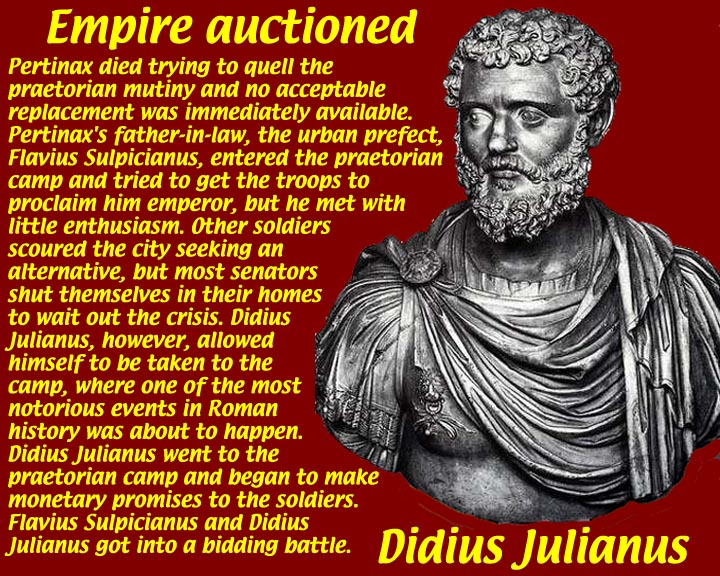
http://www.mmdtkw.org/AU0802cDidiusJulianus.jpg
http://www.mmdtkw.org/AU0802dAuctionOfEmpire.jpg
After Perinax was killed, his father, Flavius Sulpicianus, who was Urban Prefect (i.e., Rome's city manager), entered the Praetorian camp and tried to persuade them to make him emperor. The Praetorians, meanwhile sent scouts out through the city looking for other candidates. Most Senators hid, but the scouts did come up with another rich guy who wanted to be emperor. Didius Julianus, according to the accounts, stayed outside the camp and started to bid against Sulpicianus. Julianus won the bidding and was proclaimed emperor. There were riots in the streets of Rome, and meanwhile three generals were proclaimed emperor by their provincial legions. Only one, Septimius Severus, was really ready to march on Rome from his Danubian headquarters, and when Septimius Severus neared Rome, the Praetorians, knowing they couldn't fight him, decided he should be emperor. Didius Julianus was declared a criminal and executed on orders from the Senate.
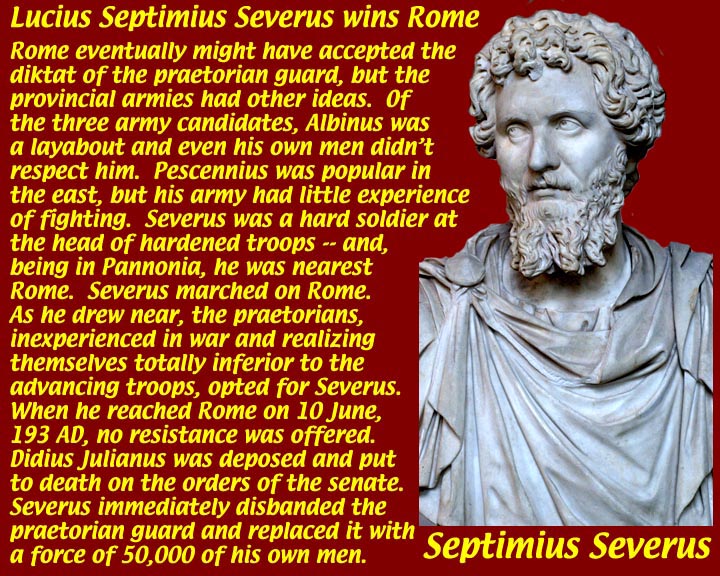
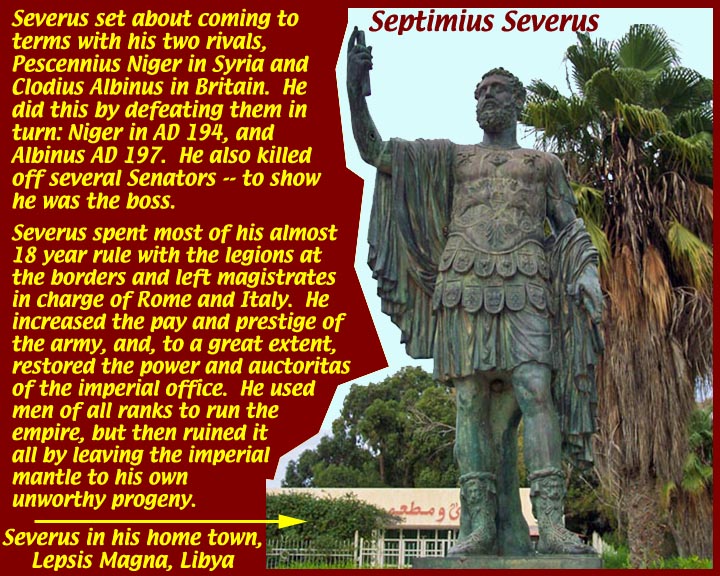
http://www.mmdtkw.org/AU0803aSeverusWins.jpg
http://www.mmdtkw.org/AU0803bSeptimusSeverus.jpg
http://www.mmdtkw.org/AU0803cSeverusLepcis.jpg
Severus marched into Rome unopposed in April of 193 AD. The first thing he did was to transfer all of the Praetorian Guards out of Rome and replace them with 50,000 of his own men. Among his next moves was the extension of Roman citizenship to all free males in the Empire. He did this to increase the tax base so that he could bump up army pay by 50 percent. He also relaxed discipline in the army. Then he used the now mollified army to ruthlessly control the state and establish his dynasty. He ruled until 211, and during this period he greatly expanded the influence and wealth of his home area of the Roman North African province. Lepcis Magna, in what is now Libya, was the biggest recipient of his largess. Septimius ran an extremely tight ship, which he staffed on the basis of ability and experience rather than on old senatorial connections. The trains ran on time. Then he ruined it all by passing authority on to his own spoiled and inept sons when he died.Starting from 208 Severus undertook a number of military actions in defense of Roman Britain against barbarian incursions and undertook reconstruction of Hadrian's Wall. He fell ill in Eburacum (York) and died there on February 4, 211.
Severus was deified by the Senate and succeeded by his sons, Caracalla and Geta, who were advised by his wife Julia Domna. The stability Severus provided the Empire was soon gone under their reign.
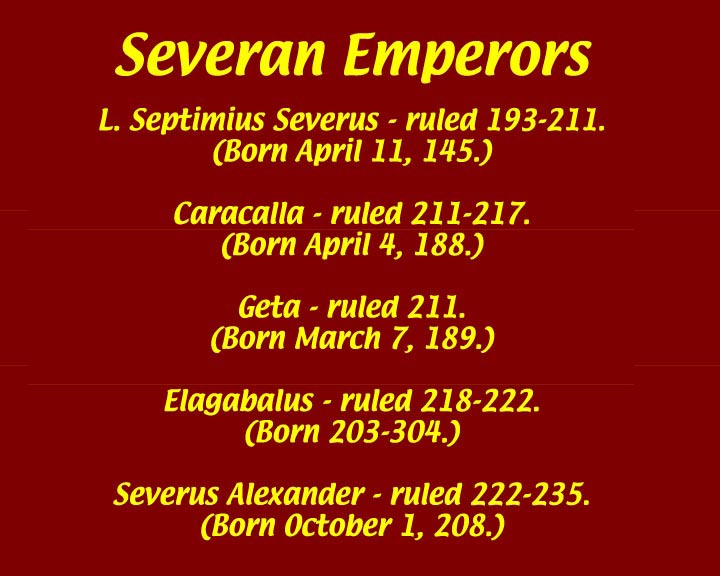
http://www.mmdtkw.org/AU0803dSeverans.jpg
http://www.mmdtkw.org/AU0803eSeveranEmperors.jpg
The Severan Dynasty started by Septimius in 193 AD ruled until 235.
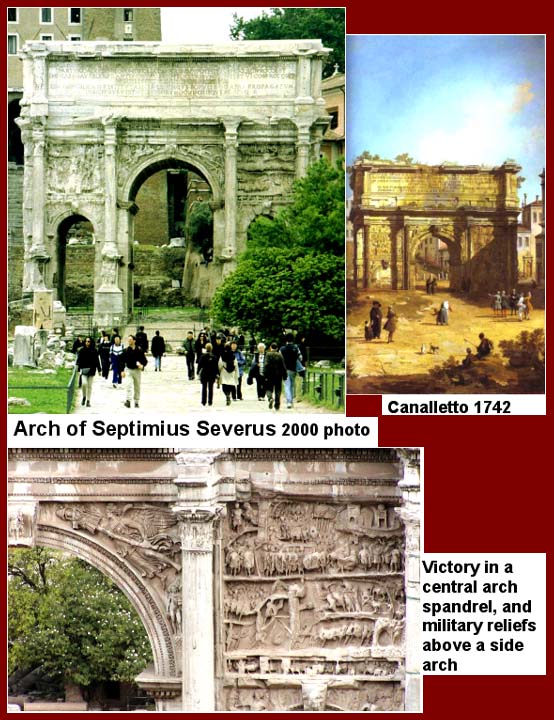
http://www.mmdtkw.org/AU0804aArchSeptSeverus.jpg
http://www.mmdtkw.org/AU0804bAarchSeptimiusSeverus.jpg
Among the architectural works of Semptimius Severus in Rome, and certainly his most durable and well known, is his triumphal arch in the Republican Forum. It was originally dedicated to Septimius and his two sons, Caracalla and Geta. After Septimius died, the two sons ruled jointly for a while, but then Caracalla either had Geta murdered or, by some accounts, personally murdered Geta while Geta cowered in the arms of his mother, Julia Domna. Geta's name was removed from the arch.
There is a subset of archeological epigraphologists who study erased or removed inscriptions. In the case of the Arch of Septimius Severus, they are able to read the removed first dedication by studying the holes that were made to mount the original bronze letters.
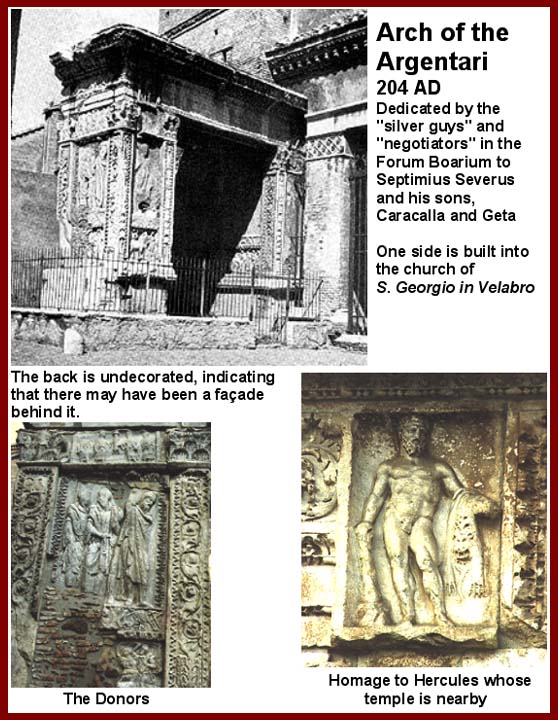
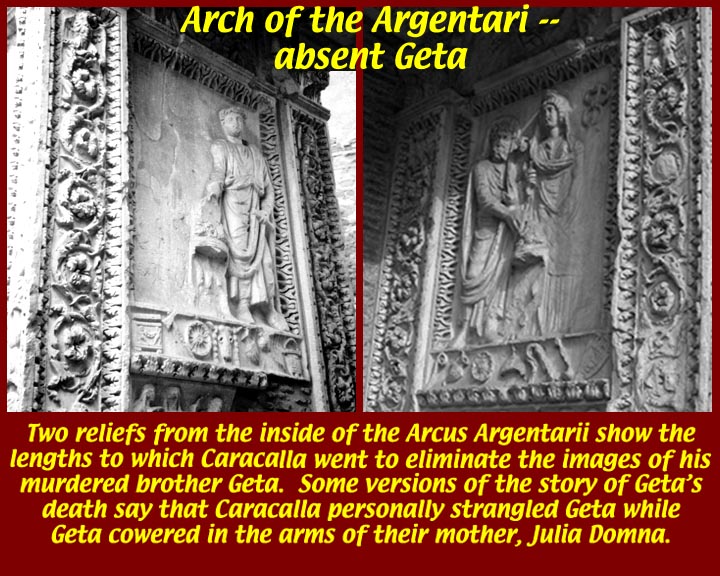
http://www.mmdtkw.org/AU0805aArchArgentarii.jpg
http://www.mmdtkw.org/AU0805bArgentariiRelief.jpg
http://www.mmdtkw.org/AU0805cGetaCoins.jpg
Another monument originally dedicated to Septimius and his two sons is the Arch of the Argentarii, which was a decorated gateway (rather than a triumphal arch) into the street on which coiners and silversmiths worked. Relief on this arch have blank areas where Geta was erased.
It was fairly easy to eliminate Geta from monuments and inscriptions, but coins had also been issued on which he was shown. It was, of course, impossible to get these coins back from the people who held them -- especially those stamped on gold and silver blanks; people tended to hoard precious metal coins and plate, and the gold coins lasted best down the centuries.
http://www.mmdtkw.org/AU0806aCaracalla.jpg
Caracalla's father, Septimius, was a Romanized Libyan Berber and his mother was from Syria. His birth name was born Lucius Septimius Bassianus and he was born in Lugdunum, Gaul (now Lyon, France), the son of the later Emperor Septimius Severus and Julia Domna. At the age of seven, his name was changed to Marcus Aurelius Septimius Bassianus Antoninus to solidify connection to the family of Marcus Aurelius. He was later given the nickname Caracalla, which referred to the Gallic hooded tunic he habitually wore and which he made fashionable.
Septimius Severus died in 211 at Eboracum (York) while touring the northern marches, and Caracalla was proclaimed co-emperor with his brother Publius Septimius Antoninius Geta. However since both of them wanted to be the sole ruler, tensions between the brothers were evident in the few months they ruled the empire together (they even considered dividing the empire in two, but were persuaded not to do so by their mother).
In December 211, Caracalla had Geta, the family of his former father-in-law Gaius Fulvius Plautianus, his wife Fulvia Plautilla (also his paternal second cousin), and her brother assassinated. He persecuted Geta's supporters and ordered a damnatio memoriae by the Senate against his brother.
Caracalla is considered to have been one of the most nefarious of Roman emperors.
Caracalla's reign was notable for:
the Constitutio Antoniniana, legalizing the grant of Roman citizenship to freemen throughout the Roman Empire, according to Cassius Dio in order to increase taxation -- he again raised the pay of the soldiery;
debasing the silver content in Roman
coinage by 25% in order to pay the legions; and
the construction of large baths outside
Rome, the remains of which, known as the Baths of Caracalla, and can
still be seen today (the outbuildings weren't completed during his
lifetime).
Caracalla's religious devotion (or
curiosity) is said to have caused his death. He had made a habit
of visiting major regional religious shrines when on campaign or
traveling. Although suspicious of the praetorian prefect
Macrinus, Caracalla allowed himself to be accompanied by only a small
bodyguard on an early spring trip from the camp at Edessa to the temple
of the moon-god at Carrhae, about 25 miles away. During the journey
back on 8 April 217, Caracalla was killed. The returning guards claimed
the emperor was ambushed while defecating, and that the alleged
assassin was one of their own, a soldier named Martialis. Martialis was
himself killed by the avenging guards, or so the story went. Suspicion
was strong that Macrinus arranged the entire affair.
Macrinus was proclaimed emperor but never
made it back to Rome. He continued the Parthian war and 13 months
later he was himself assassinated by partisans of Elagabalus, a nephew
and pretended son of Caracalla.
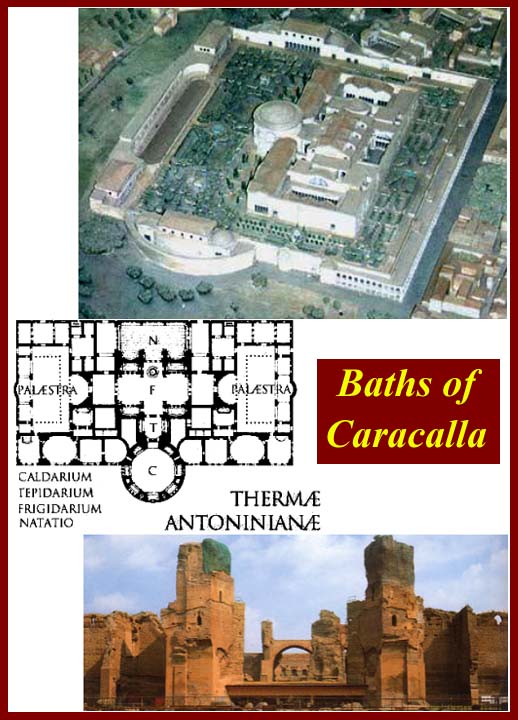
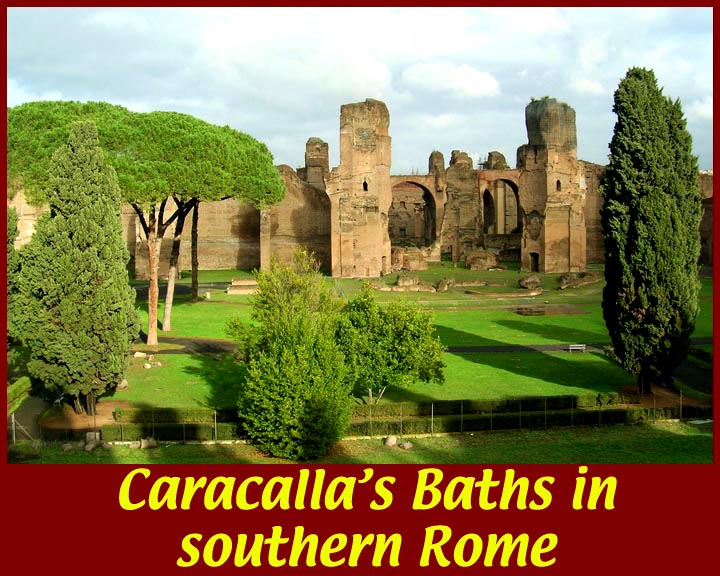
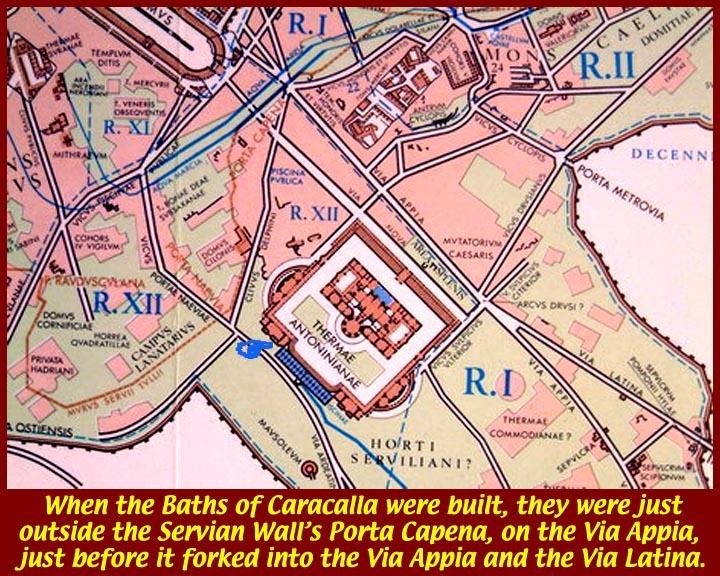
http://www.mmdtkw.org/AU0806bBathsCaracalla.jpg
http://www.mmdtkw.org/AU0806bxCaracallaBaths.JPG
http://www.mmdtkw.org/AU0806cCaracallaBaths.jpg
http://www.mmdtkw.org/AU0806dBathsCaracalla.jpg
http://www.mmdtkw.org/AU0806deUnionStation98.jpg
The Antonine Baths ("Baths of Caracalla") were built along the Via Appia just outside the Porta Capena of the Servian walls. They were later included in the area enclosed in the Aurelian Walls. They were the largest of the public baths built in Rome. See http://en.wikipedia.org/wiki/Baths_of_Caracalla for more information.
Union Station in Washington DC and Pennsylvania Station in New York City copy the interior and exterior architecture of the Baths of Caracalla.
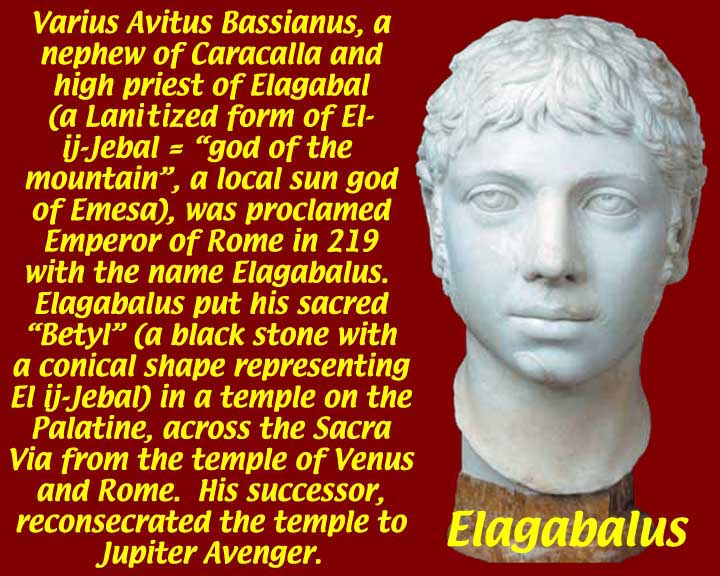
http://www.mmdtkw.org/AU0807aElagabalus.jpg
http://www.mmdtkw.org/AU0807bElagabalusTemple.jpg
Elegabalus was just a boy and a strange little boy he was. He was totally dominated by his powerful Syrian grandmother (also the grandmother of Caracalla) and his mother (sister of the mother of Caracalla). At an early age he became High Priest of a cult dedicated to a Syrian god whose name was rendered by the Romans as Elagabal -- clearly El Ij-Jebal, "god of the mountain" in Northern Semitic. "Elagabal" was a sun god, and Elagabalus built an Elagabal temple on the flank if the Palatine Hill across the Via Sacra from the Temple of Venus and Roma. There he led rites to Rome's new supreme god Elagabal, otherwise known as Sol Invictus. His successor rededicated the temple to Jupiter the Avenger, but the syncretic Romans coopted Elagabal/Sol Invictus into their own pantheon and often identified Sol Invictus with Apollo. Early Christians, especially Roman early Roman Christian converts, used the imagery of Sol Invictus/Apollo in representations of Christ.
During his rule, Elagabalus showed a disregard for Roman religious traditions and sexual taboos. He was married as many as five times and was alleged to have prostituted himself in the imperial palace. He was also accused of dressing like a woman, but that may have been a reference to his eastern priestly robes.
Amidst growing opposition, Elagabalus, only 18 years old, was assassinated and replaced by his cousin Severus Alexander on March 11, 222, in a plot formed by his own grandmother, Julia Maesa, and members of the Praetorian Guard. Elagabalus developed a reputation among his contemporaries for eccentricity, decadence, and zealotry which was likely exaggerated by his successors and political rivals.
This propaganda was passed on and, as a result, he was one of the most reviled Roman emperors to early historians.
http://www.mmdtkw.org/AU0808aAlexanderSeverus.jpg
Marcus Aurelius Severus Alexandinus, commonly called Alexander Severus (ruled 222–235), was the last emperor of the Severan dynasty, having succeeded his despised second cousin, the eighteen year old Emperor Elagabalus. As a mark of contempt, he had Elagabalus's body thrown into the Tiber river. He and Elagabalus were both grandsons of the influential and powerful Julia Maesa, who had earlier orchestrated the acclamation of Elagabalus by the Legio III Gallica as emperor.Severus Alexander was in turn assassinated at the hands of his own troops after suffering a defeat at arms against the Germanic tribes. He had first tried diplomacy and bribery, which alienated the legions and then lost the battle. His assassination is considered to have been the start of "The Crisis of the Third Century" -- the nearly fifty years of disorder, multiple civil wars between warring claimants to his title, economic chaos, regional rebellions, and various external threats which followed.
http://www.mmdtkw.org/AU0808bMilitaryChaos.jpg
During the 50 year long "Crisis" between the death of Alexander Severus and the advent of Diocletian at least 65 emperors and pretenders fought for supremacy. And Diocletian's rule only stayed but didn't end the chaos.
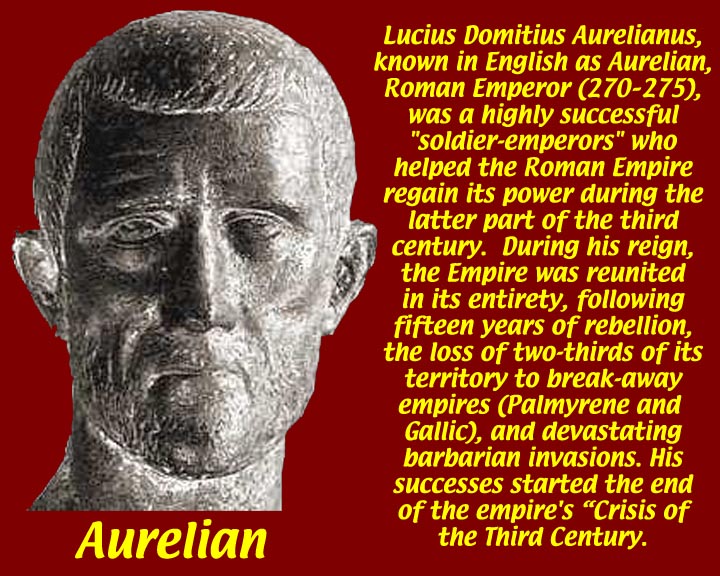
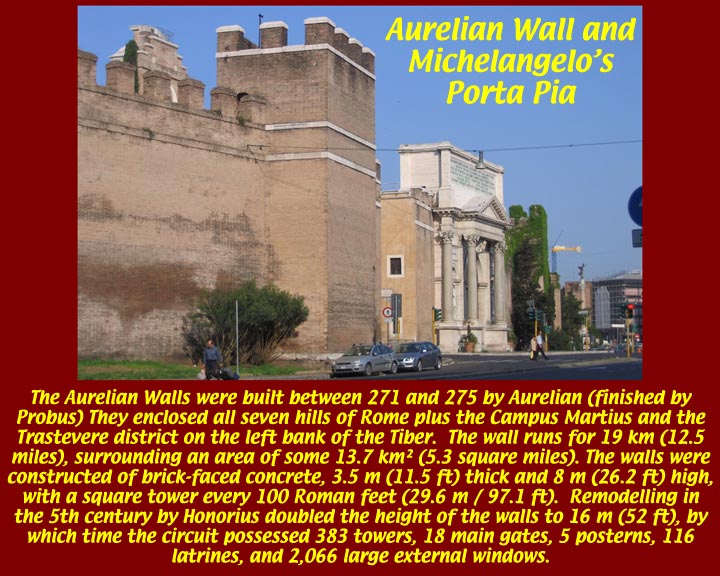
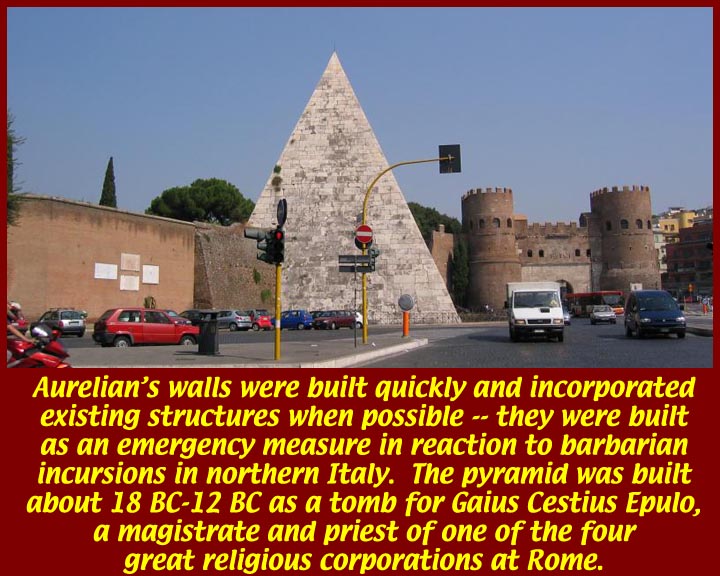
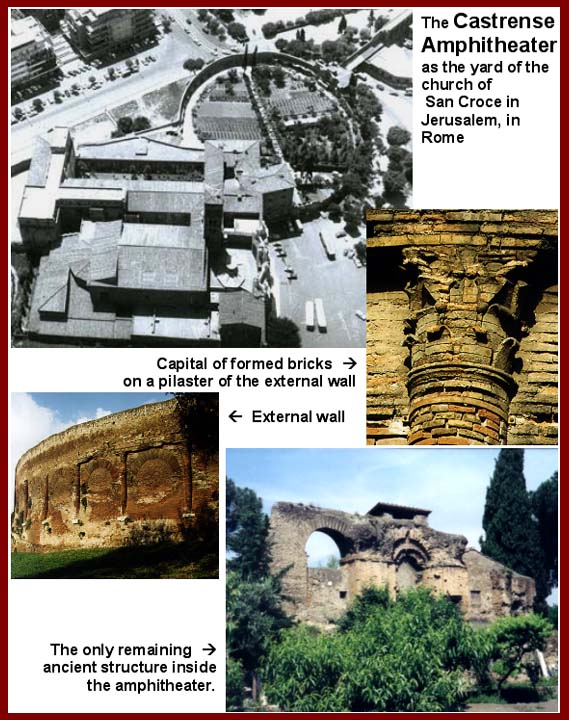
http://www.mmdtkw.org/AU0809aaAURELIAN.JPG
http://www.mmdtkw.org/AU0809aAurelianWall.JPG
http://www.mmdtkw.org/AU0809bAurelianWallCestiusPyramid.jpg
http://www.mmdtkw.org/AU0809cAmphCastrense.jpg
http://www.mmdtkw.org/AU0809dAurelianWall.jpg
One of the consequences of the crisis was Rome's inability to keep the barbarians at bay. Lucius Domitius Aurelianus, known to history as Aurelian, built new walls around an expanded Rome after barbarians started to encroach on northern Italy. A successful "soldier emperor", he also was able to reunite the empire, which had lost two-thirds of its territory to break-away Gallic and Palmyrene "empires in the 15 years prior to his advent in 270 AD. (Propaganda of Diocletian later ignored this reunification.) His reign is often cited as the "beginning of the end" of the Crisis.
Like so many of his predecessors during the crisis, Aurelian was assassinated by members of his court; the story of the fraudulent threat to their lives, which supposedly provoked the assassination is at http://en.wikipedia.org/wiki/Aurelian#Death.
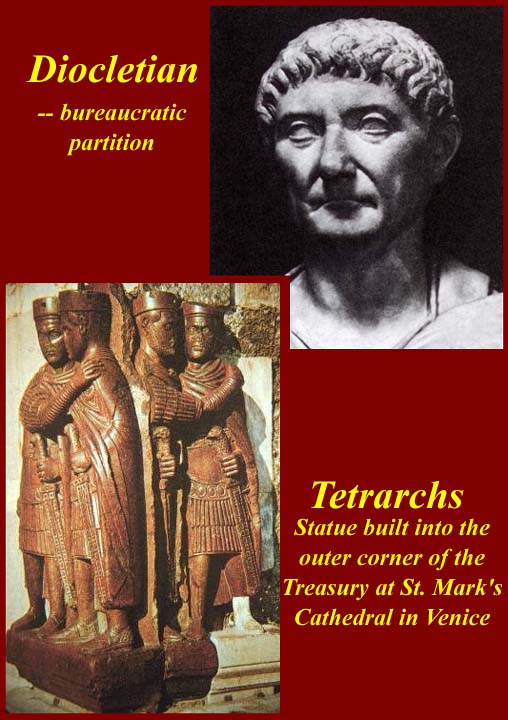
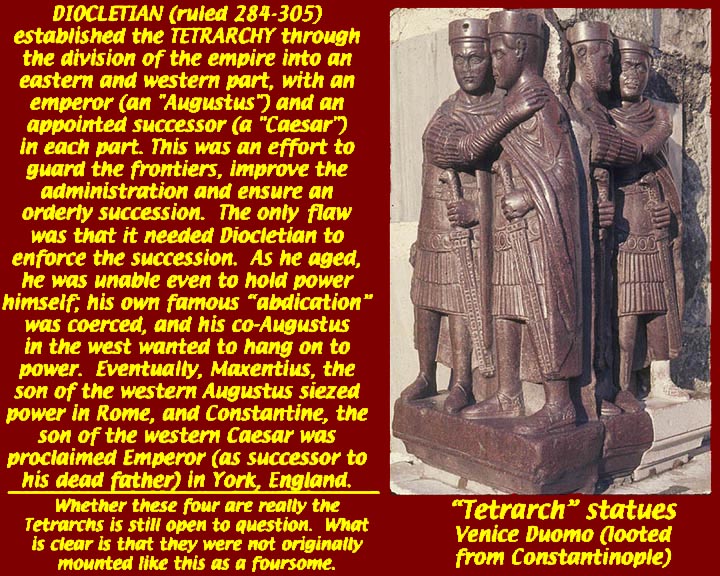
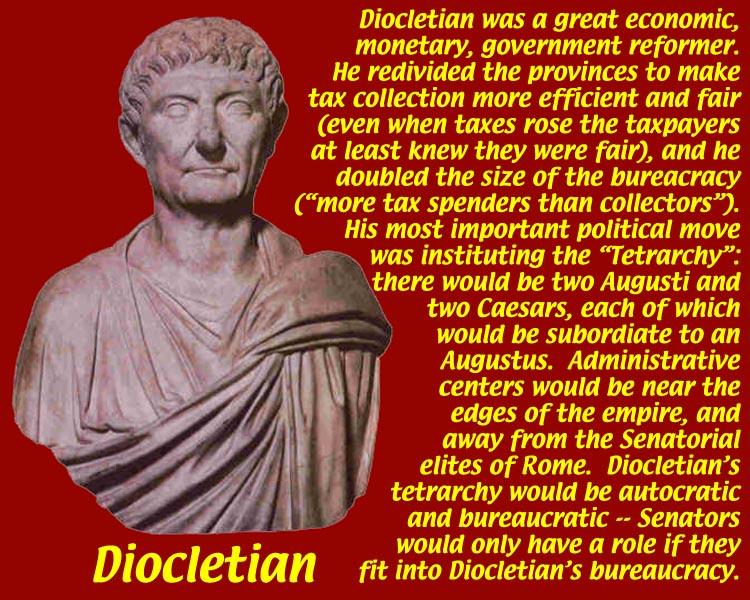
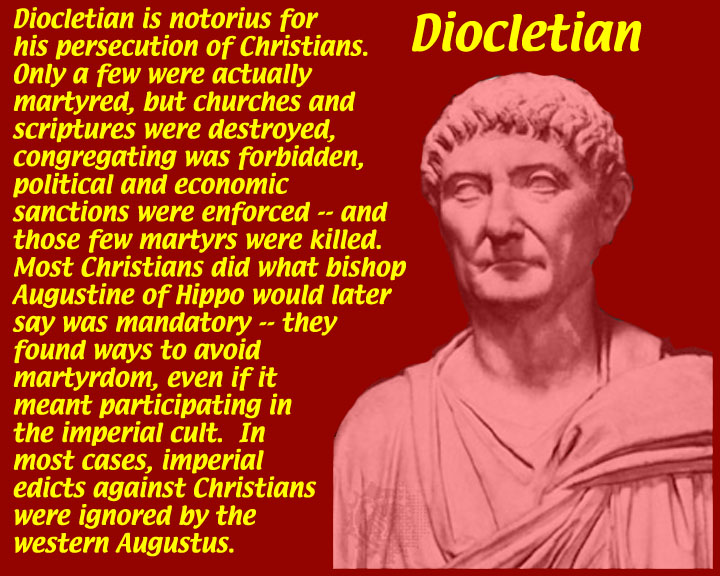
http://www.mmdtkw.org/AU0810aDiocletianTetrarchs.jpg
http://www.mmdtkw.org/AU0810baTetrarchs.jpg
http://www.mmdtkw.org/AU0810bDiocletian.jpg
http://www.mmdtkw.org/AU0810cDiocletianPersecutions.jpeg
http://www.mmdtkw.org/AU0811DiocletiansDivisions.jpg
Diocletian, who ruled from 284 to 305 AD, is credited with bringing the empire back under control. He was actually building on the work of one of his predecessors, Aurelian, but Diocletian's propaganda always gave all the credit to Diocletian -- Aurelian was never mentioned. He did manage to reform the currency by returning it to earlier levels of purity. His government reforms were sweeping: he decided there would be two senior administrators, himself and another "Augustus". Each Augustus would be assisted by a junior administrator, and those two junior officers would be called "Caesars". None of the four administrators would live in Rome; all four had capitals nearer to troublesome border areas. The rule of the two Augusti and two Caesars was called the "tetrarchy" which simply means "rule by four". (It's notable that "tetrarchy" has Greek language roots. In earlier years their rule might have been called a "quadrumvirate", a word with Latin roots. Diocletian's HQ was in Greek speaking Nicomedia on the southern shore of the Black Sea -- near Constantine's eventual new capital, Constantinople (Byzantium).)
The only problem with the tetrarchy was that it only lasted as long as Diocletian was there to keep it functioning. As he aged (and sickened) his "Caesar" (deputy), Galerius, put increasing pressure on him to abdicate, and Diocletian finally agreed. The deal was that both Augusti would retire and then each Caesar would become an Augustus and appoint a new Caesar. Diocletian retired to his palace in Split (now in Croatia), and the process began. Needless to say, there were powerful disappointed applicants for the Caesar offices. There was a particular problem in the west where two juniors, relatives of the former western rulers both seized power in their spheres. Maxentius grabbed the office of his father, the retired western Augustus, Maximian. Meanwhile, Constantine forcibly succeeded to the office of his father, Constantius, the former western Caesar when Constantius died in England. There was a lot of jostling. For a time, Maximian even came out of retirement to fight against his son Maxentius -- and Diocletian briefly reemerged to act as referee. The details of who fought who are mired in controversy. It finally came down to a race for Rome between Maxentius and Constantine.
Rome had remained the religious capital, but the pagan "old time religion" was already becoming less important as the worship of eastern "mystery religions" spread (Mithraism, Isis worship, the Sol Invictus cult, the Eleusian Mysteries -- Demeter and Persephone -- and, increasingly, Christianity). The empire had no problem accepting most of these cults. Roman religion had always been syncretic. But monotheistic Christianity and Judaism, of which Rome viewed Christianity as a variant, was a different jug of garum. Some Christians, actually very few of the total Christian numbers, refused the imperial cult its required pinch of incense and were thereafter persecuted. "Persecution" seldom included martyrdom. (it's worth reiterating that Christians later killed many more Christians -- mutually accused "heretics" -- than the Romans ever killed.)
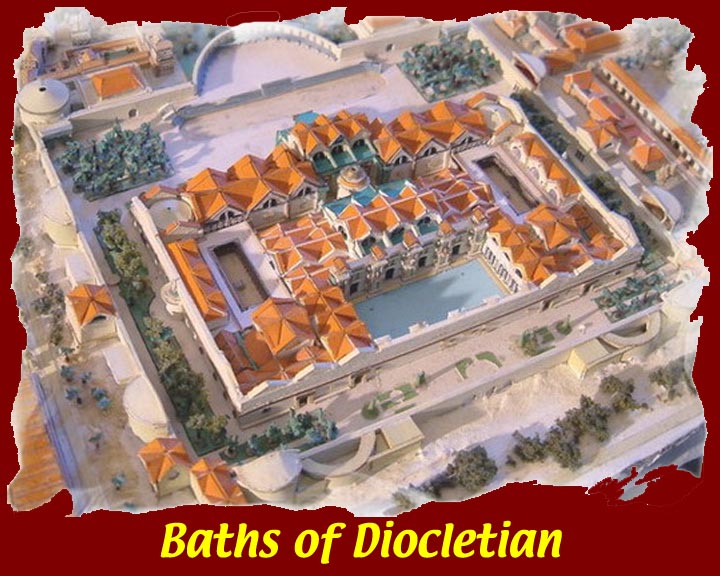
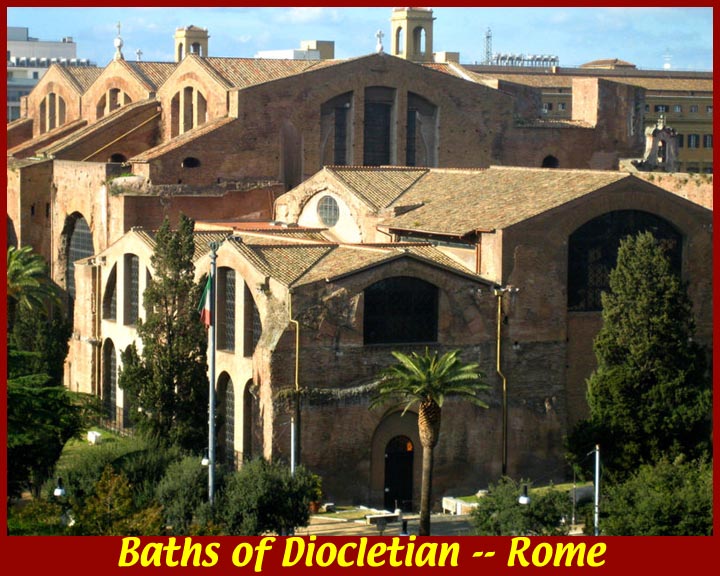
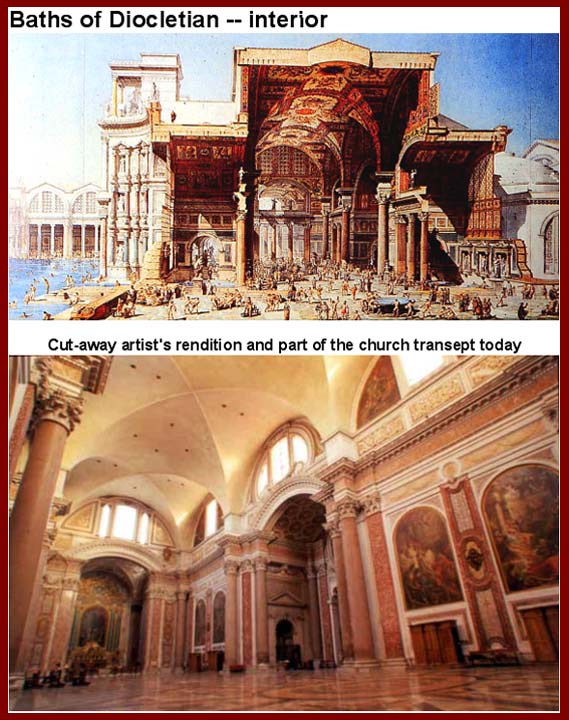
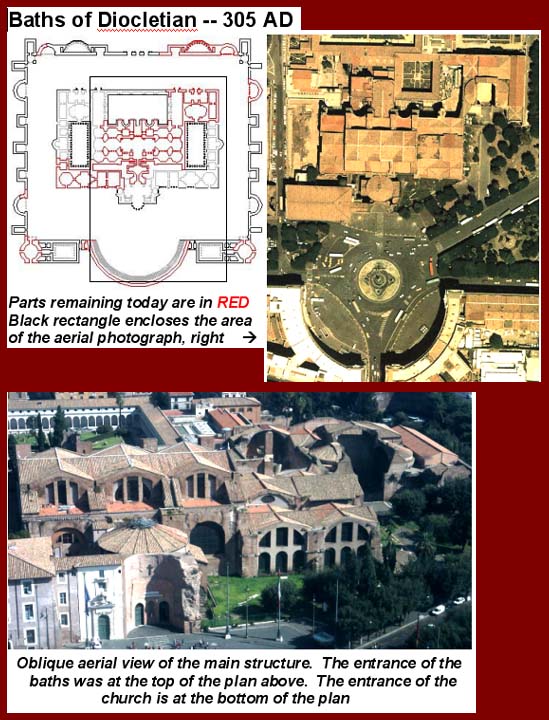
http://www.mmdtkw.org/AU0812aaDiocletianBathsRome.jpg
http://www.mmdtkw.org/AU0812aBathsDiocletian.jpg
http://www.mmdtkw.org/AU0812bDiocletianBathsImage3.jpg
http://www.mmdtkw.org/AU0812cDiocletianBathsImage2.jpg
http://www.mmdtkw.org/AU0812dDuPeracPreMCa1670.jpg
Although Diocletian's headquarters was far from Rome, he still did well by its citizens by setting up yet another set of public Baths. Diocletian's baths are better preserved than any of the others in Rome, because major parts of the baths were reused as a Christian religious establishment: the Church of St. Mary of the Angels and Martyrs still occupies the largest hall of of the baths, and adjacent parts were rectories, convents and guest houses. The church and one rectory still function, but other adjacent buildings have become a school of the arts and parts of the National Museum system. As can be seen in some of the images above, major parts of the original structure have been kept in very good repair.
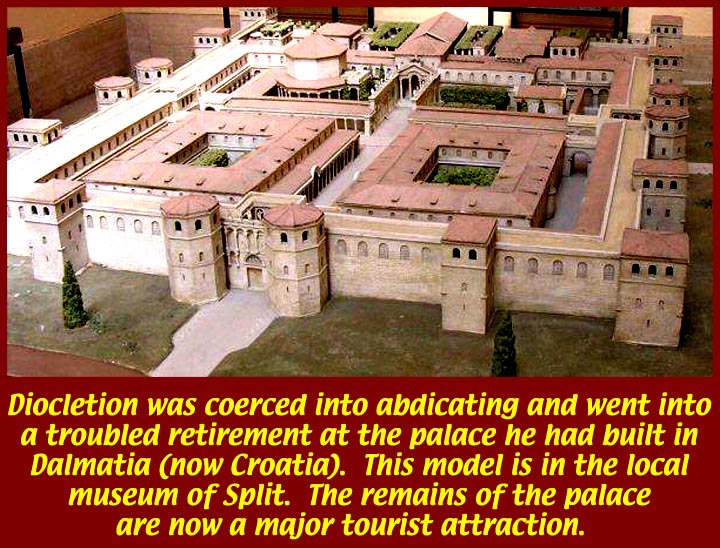
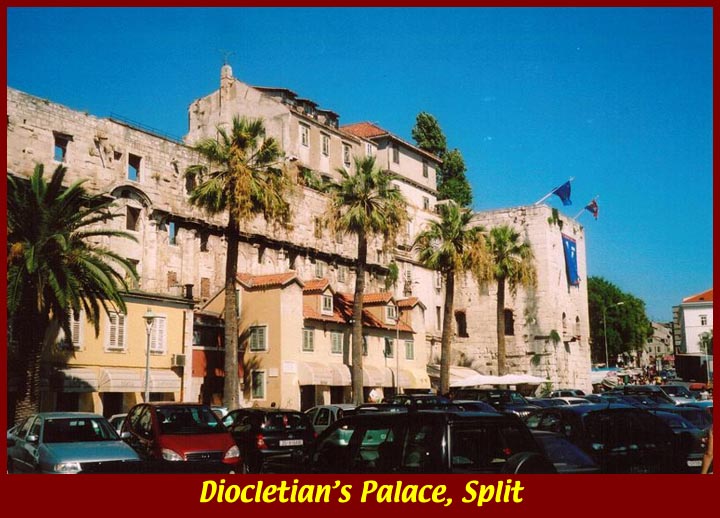
http://www.mmdtkw.org/AU0812eDiocletianSplit1.JPG
http://www.mmdtkw.org/AU0812fDiocletianPalace.JPG
http://www.mmdtkw.org/AU0812gSplitPalaceDiocletian.jpg
Diocletian's retirement was spent at Split.
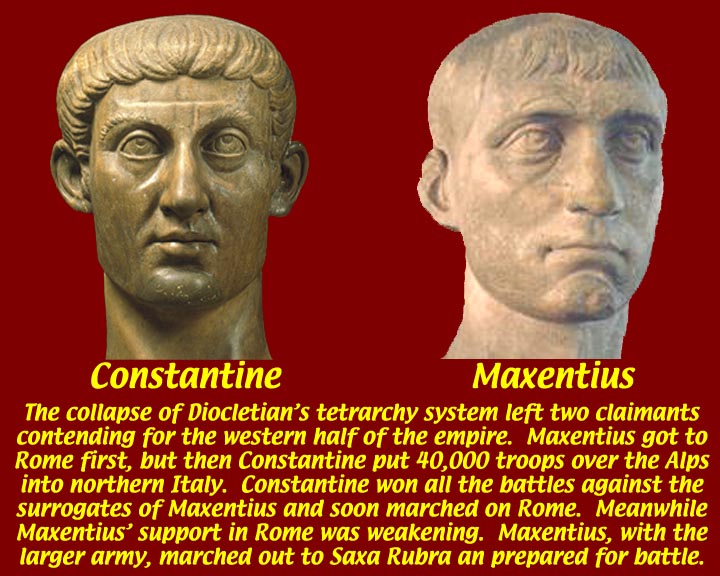
http://www.mmdtkw.org/AU0813aMaxentiusConstantine.jpg
http://www.mmdtkw.org/AU0813bConstantineMuseiCapitolini.jpg
Maxentius got to Rome first and moved in behind Aurelian's walls. He apparently wanted to wait inside while Constantine ravaged northern Italy, but strong land-owning groups in the city pressed him to fight Constantine before he gobbled up most of the countryside. Constantine had some notable victories in the north against surrogates of Maxentius and then advanced toward Rome. It's worth noting that Maxentius was making overtures to Rome's growing Christian community, but not getting very far. Rome was, at any rate, still a predominantly pagan city and the Christians had little power. What Maxentius appears to have been doing was trying to prevent a possible Christian fifth column.
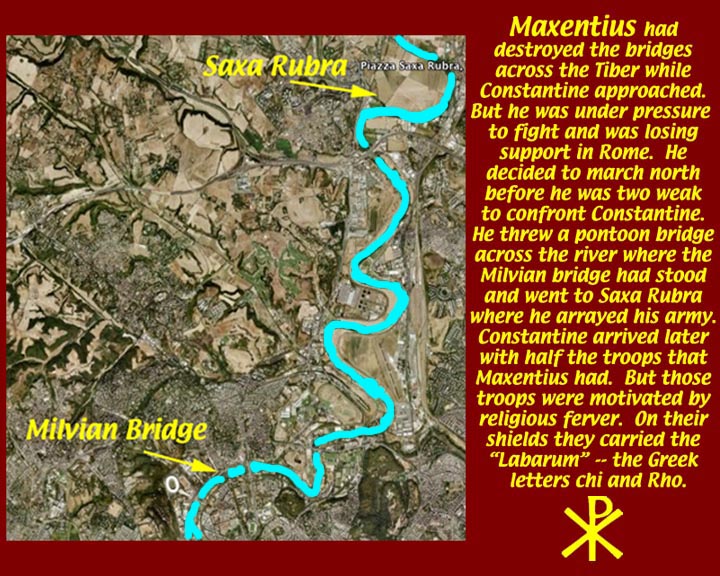
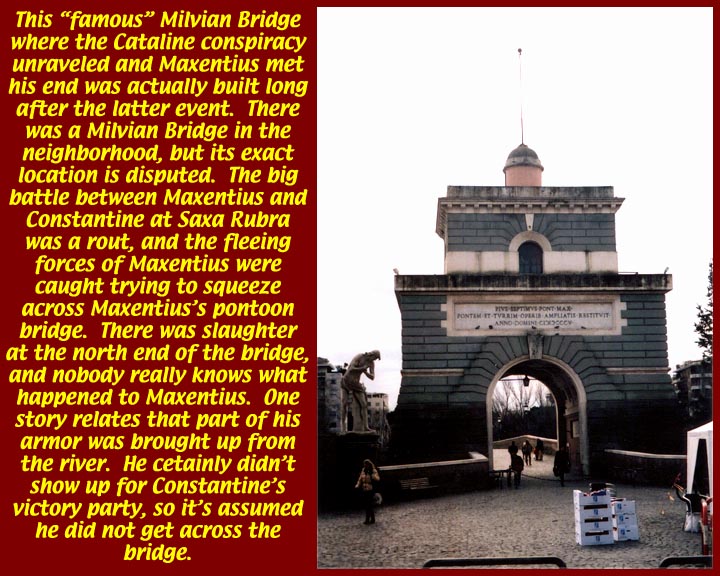
http://www.mmdtkw.org/AU0813cSaxaRubra.jpg
http://www.mmdtkw.org/AU0813dMilvianBridge.jpg
http://www.mmdtkw.org/AU0813eRaphaelMilvio.jpg
Maxentius had a larger force than did Constantine, but he was worried that, if he didn't use it, they all might be weakened by a siege of Rome. In October of 312 AD, he marched his legions out of the city and over a pontoon bridge that replaced the Milvian Bridge that he had earlier destroyed as a defensive measure. He arrayed his forces at Saxa Rubra, several miles north of the bridge, but he deployed them badly, giving them no possibility of retreat -- he was simply overconfident. In the event, the troops of Maxentius were not prepared for the newly religiously motivated Constantinian forces, who had reportedly seen something in the sky that energized them. Almost all people in the West are probably aware of the religious interpretation of what they and Constantine saw before the battle. After the fact, Constantine reported having one or possibly two other miraculous visions.
Constantine's legions slaughtered those of Maxentius, who had been backed into a bend of the Tiber River. Those who escaped fled back southward until they were caught at the pontoon bridge bottleneck. In the crush, many fell into the River, and, by some accounts, the pontoon bridge collapsed. A body identified as that of Maxentius was recovered from the Tiber. Some pieces of armor said to have belonged to Maxentius were later recovered from the River. A head, again said to be that of Maxentius, was carried through Rome during Constantine's triumphal entry into the city.
Constantine marched into a Rome that no longer had a defending army. He was, of course immediately acclaimed. It took Constantine several years to conquer the eastern half of the Empire, but, when he did, he stayed there, establishing his new capital in Constantinople, near his mother's home town and near the major current threats to the Empire's borders.
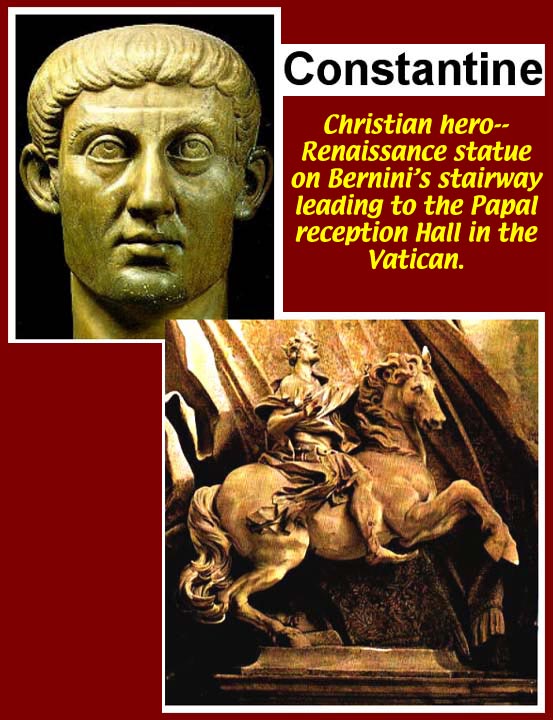
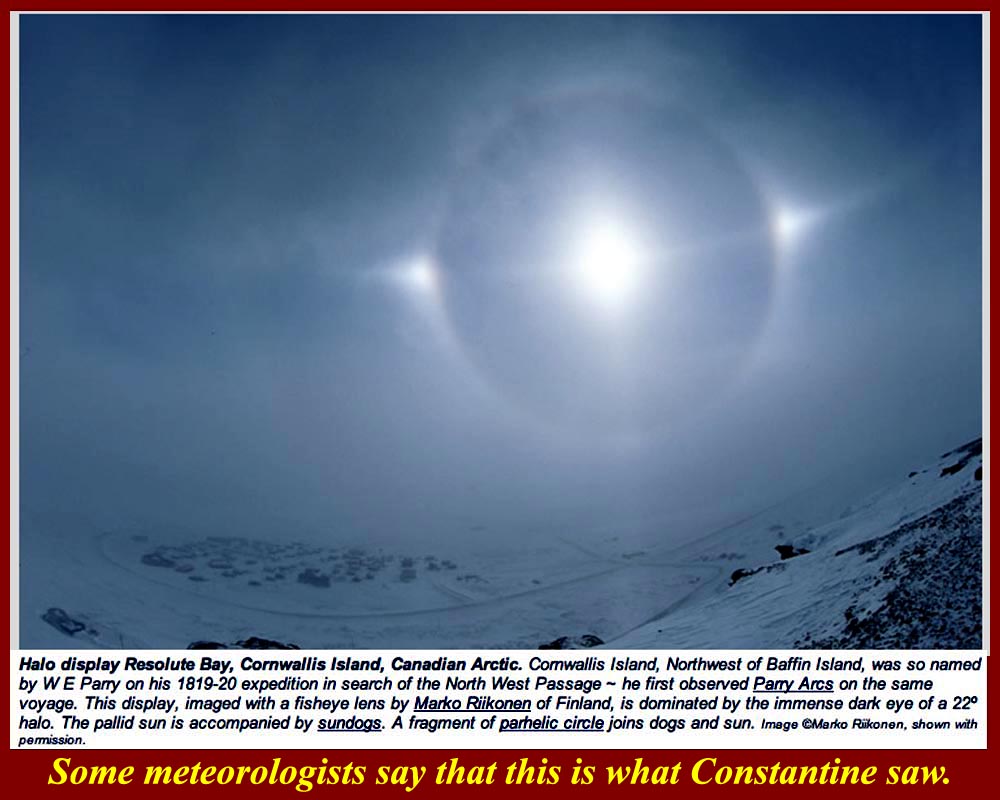
http://www.mmdtkw.org/AU0813fConstantineImage.jpg
http://www.mmdtkw.org/AU0814aConstantineVision.jpg
http://www.mmdtkw.org/AU0814bSirenteImpact.jpg
So what was the miraculous sky phenomenon? It's important to remember that, unlike the dream visitations that only Constantine reported, everybody reportedly saw what happened in the sky. For years, meteorologists have put out the idea that what they saw may have been some kind of "solar pillar" or "sun dog" phenomenon, such as that shown in the second image above. Anyone who lives in the icy cold north is familiar with these, but it would have been a rare and possibly unprecedented sight near Rome. The sun dog theory held sway for much of the latter half of the 20th century.
In the late 1990s, a new theory involving a meteorite impact in the Sirente Valley east of Rome got some publicity. Radiocarbon dating places the impact at about the right date, and trajectory studies based on "splash" from the impact indicate that the meteorite came in at a shallow angle (which would have made it a fireball as it came through th atmosphere) and that it must have passed almost directly over Rome. In fact, if it had arrived a second or so sooner, the impact might have vaporized the whole city. The Sirente meteorite should have been visible throughout the region, and, other than the one reported before the Saxa Rubra battle, no sky phenomenon was reported during those years. It's a persuasive argument, but there is no way to prove it one way or another. A 2003 BBC account of this theory is available on the Internet at http://news.bbc.co.uk/2/hi/science/nature/3013146.stm.
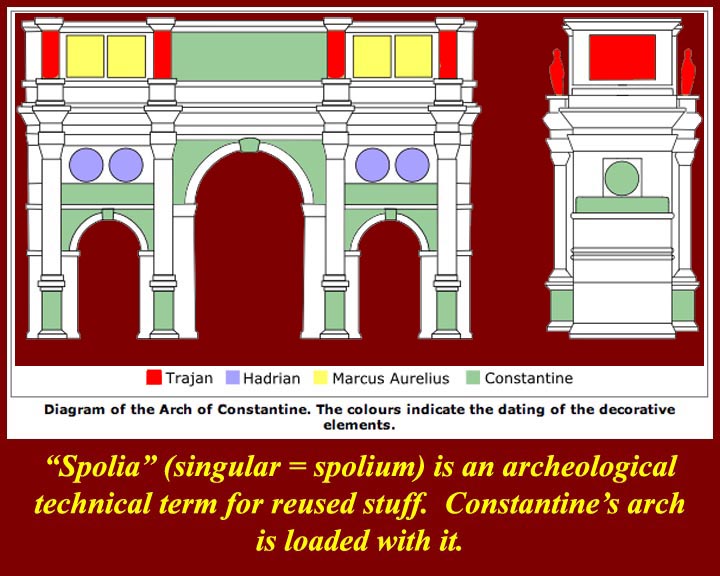
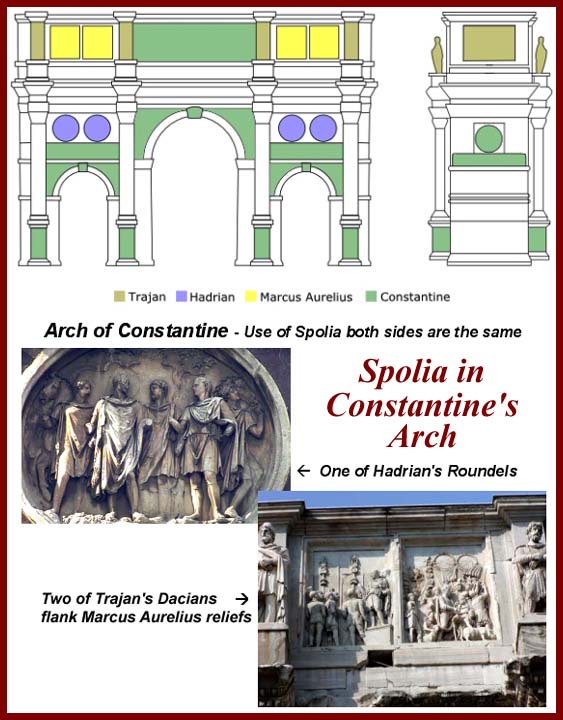
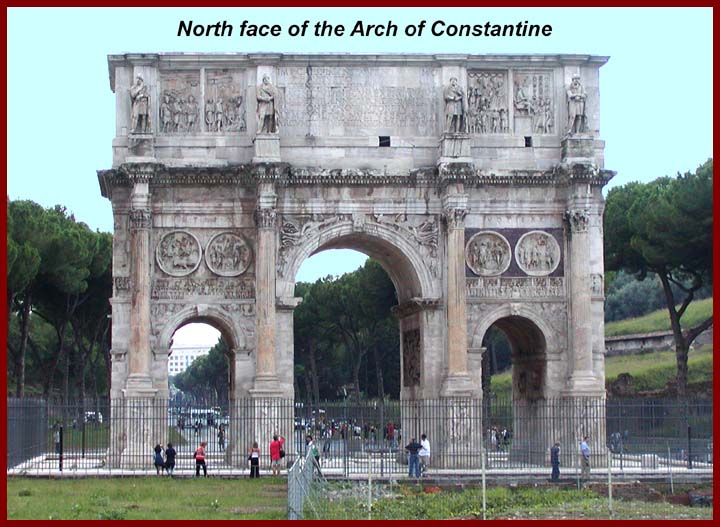
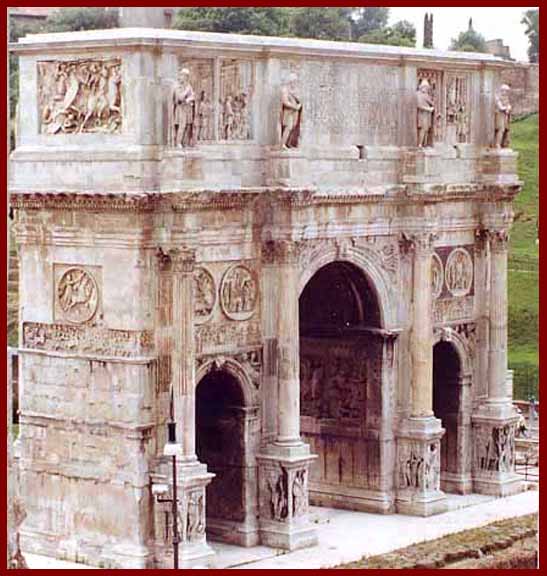
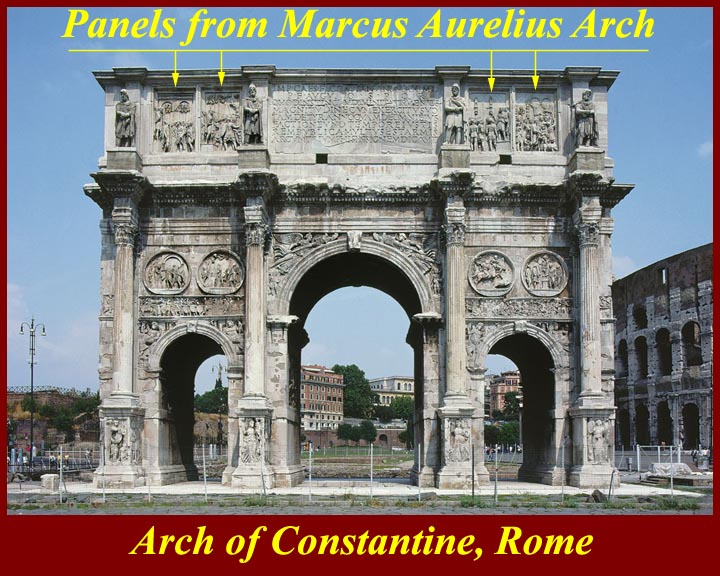
http://www.mmdtkw.org/AU0819acConstantineArchSpolia.jpg
http://www.mmdtkw.org/AU0819bArchConstantine.jpg
http://www.mmdtkw.org/AU0820aArchConstantineNFace.jpg
http://www.mmdtkw.org/AU0820bArch-Constantine.jpg
http://www.mmdtkw.org/AU0821cConstantineArch.jpg
http://www.mmdtkw.org/AU0821dComparison.jpg
One of the monuments on every Rome itinerary is the Arch of Constantine, if for no other reason than that it stands right next to the Colosseum. It was not in place when Constantine held his triumphal parade through Rome in 312 AD. Stone triumphal arches were built after the fact to replace temporary wooden arches that were set up for the Triumph. Constantine left town fro the East soon after defeating Maxentius and returned in 322 for the dedication of this arch on the 10th anniversary of his victory. He returned for his second and last visit another ten years later for the 20th anniversary. The decoration of the arch is composed almost entirely of "spolia", pieces taken from monuments of earlier emperors. In the top tier reliefs that were taken from a supposed earlier arch of Marcus Aurelius, new heads with the visage of Constantine were used to replace the original heads of Marcus Aurelius. The heads were replaced again in the 19th century in an attempt to spruce up the arch for the burgeoning tourist trade.
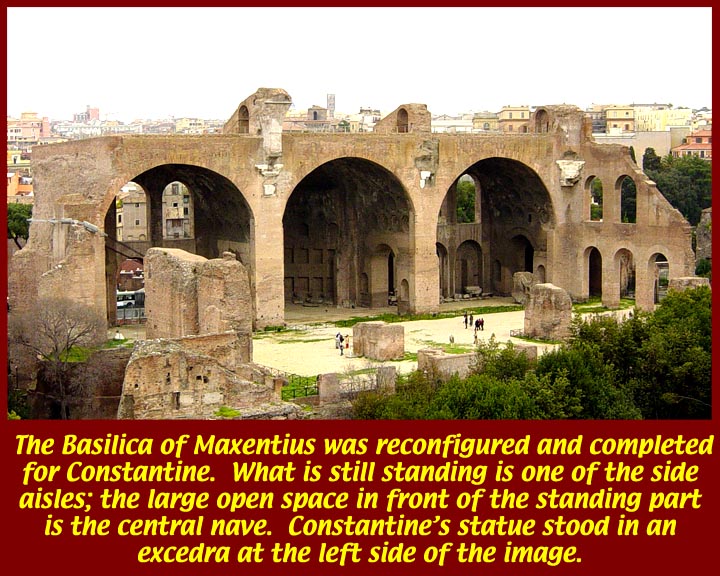
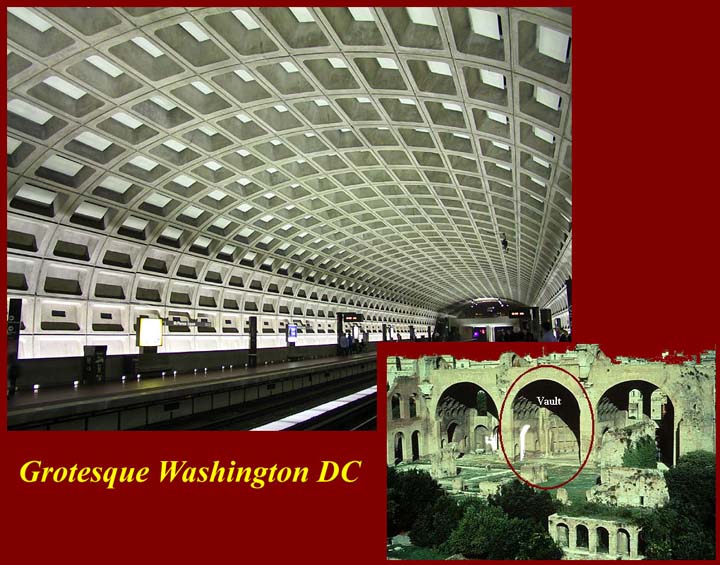
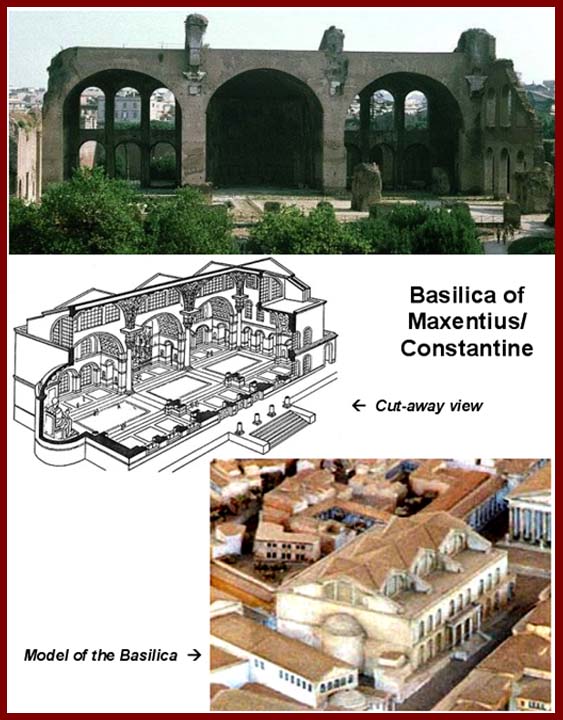
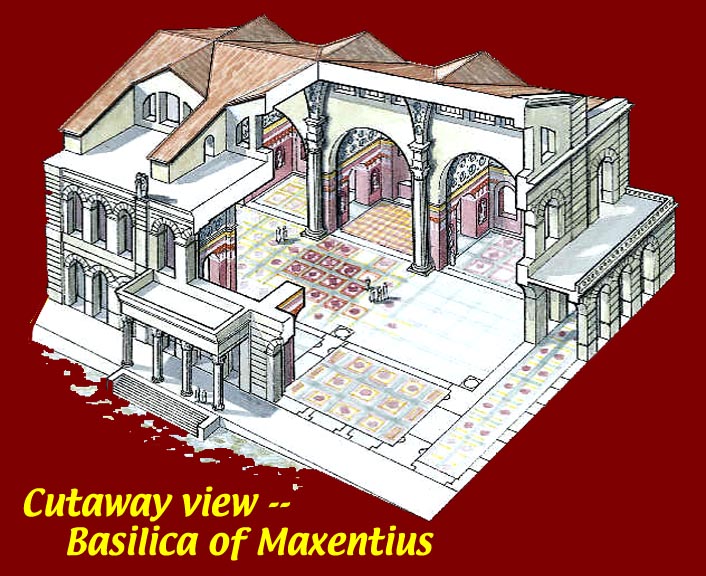
http://www.mmdtkw.org/AU0822aBasilica_of_Maxentius_and_Constantine.jpg
http://www.mmdtkw.org/AU0822awDCSubwayGrotesque.jpg
http://www.mmdtkw.org/AU0822axBasilicaMaxConstant.jpg
http://www.mmdtkw.org/AU0822bBasilica Max.JPG
The Basilica of Maxentius was completed by Constantine after he took the city, but it is still known to archeologists and tourists as the Basilica of Maxentius. It is the largest basilica in the forum area and it once held the colossal seated statue of Constantine.
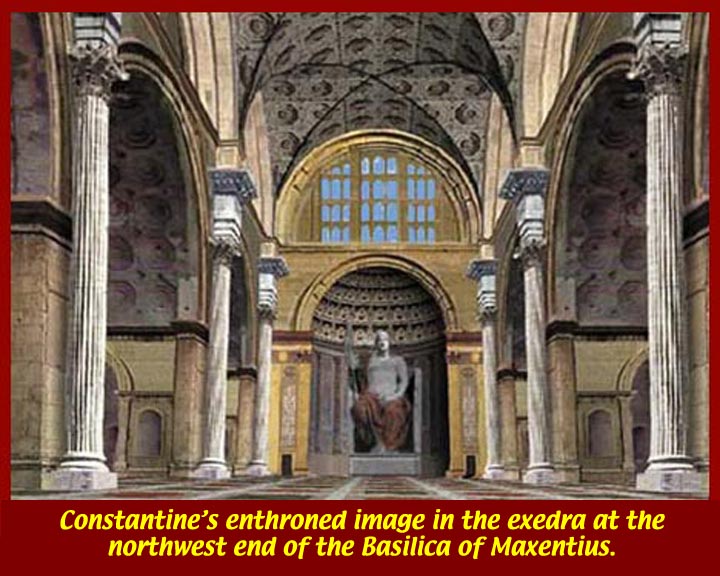
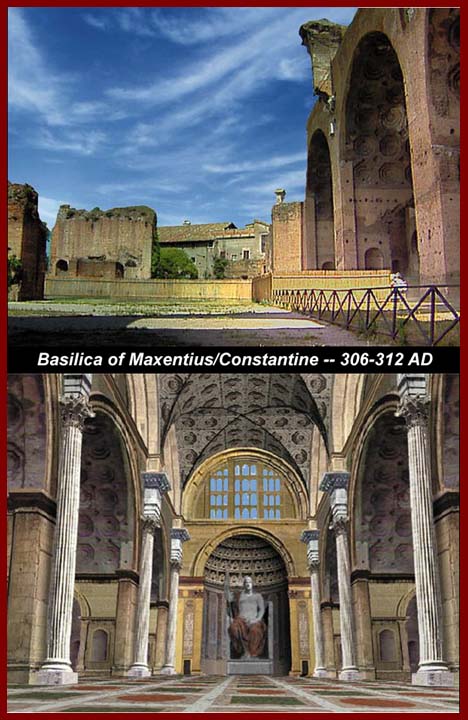
http://www.mmdtkw.org/AU0822cBasMaxentius.jpg
http://www.mmdtkw.org/AU0822cxBasMaxentius.jpg
http://www.mmdtkw.org/AU0822dConstantineInMaxentiusBasilica.jpg
The Constantine statue is thought to have occupied the exedra at the northeastern end of the basilica. Important court cases would have been tried in front of the statue with a magistrate sitting on a curile chair directly in front of the statue. A judge's rulings were issued in the name of the emperor in front of his image. Based on surviving fragments, it is estimated that the Constantine statue was about 40 feet high -- twice as high as the Lincoln statue in the Lincoln Memorial in Washington. The statue would have about eight times the mass of the Lincoln statue if it were solid stone, but it's thought that the Constantine statue was "acrolithic". In acrolithic statues, those parts covered in cloth were only framework while the parts of the body that showed were in stone. This kind of statue was often used to minimize the weight that the floor would need to support.
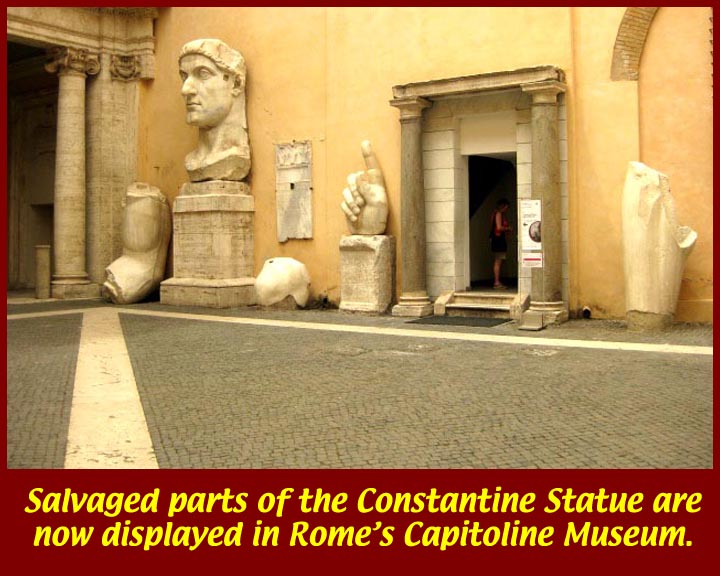
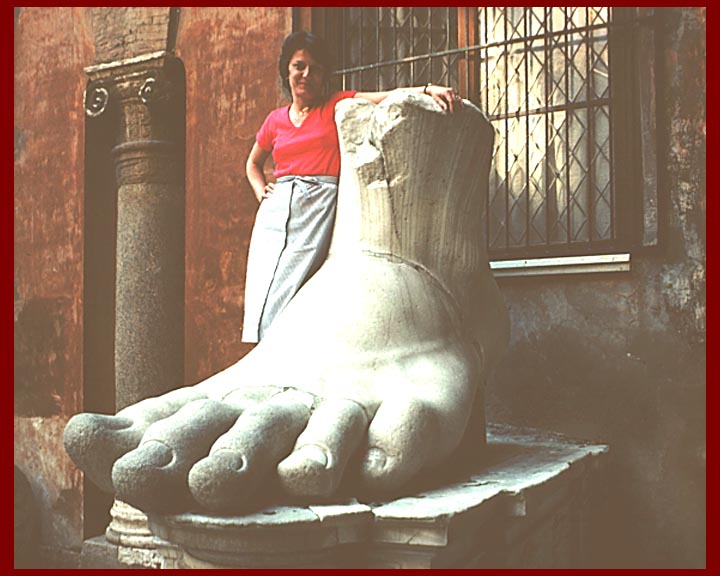
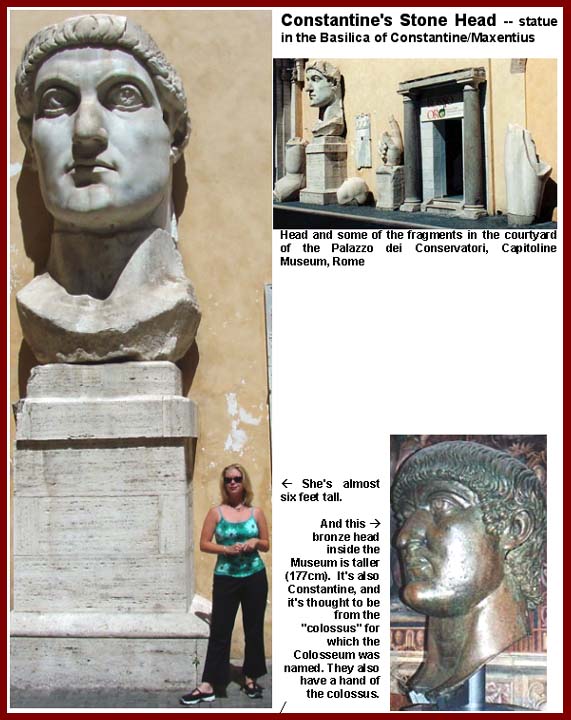
http://www.mmdtkw.org/AU0822eConstantineStatue.JPG
http://www.mmdtkw.org/AU0822fConstantineColossalFoot.jpg
http://www.mmdtkw.org/AU0822fxConstantineHead.jpg
http://www.mmdtkw.org/AU0822gConstantineBronzeCapitoline.jpg
Recovered parts of the Constantine statue are now displayed in the Capitoline Museums in Rome. Also displayed there is a very large bronze head thought to have been the one that Constantine caused to be put on Nero's colossus.
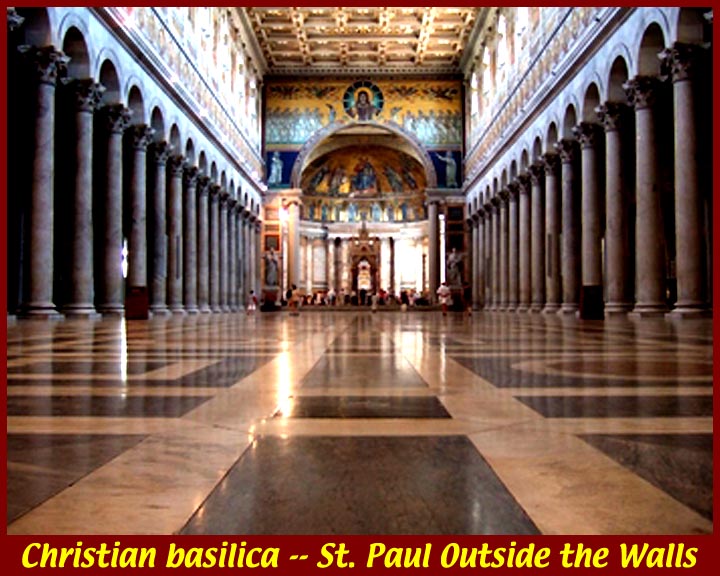
http://www.mmdtkw.org/AU0823aSPaoloExtraMuros.jpg
http://www.mmdtkw.org/AU0823bLateranPlanIsom.jpg
Constantine also famously financed the construction of Christian basilicas in Rome.
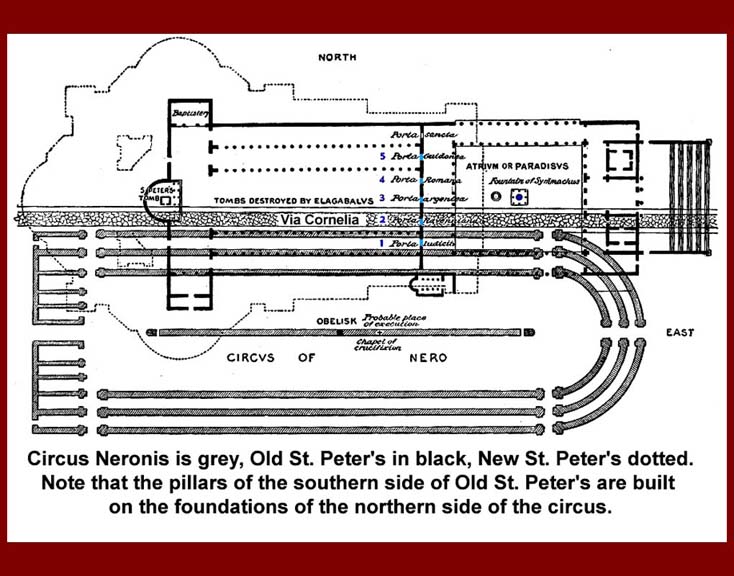
http://www.mmdtkw.org/AU0824aStPeLancianiPlan.jpg
http://www.mmdtkw.org/AU0824bStPeAedicula.jpg
Constantine's basilica of St. Peter has always been considered to be a "martyrion", a church that marked the place of martyrdom or burial (or both) of a Christian martyr. The first structure at the supposed site of the martyrdom of Peter was a small 2nd or 3rd century shrine. That shrine was incorporated in Constantine's basilica and is under the main altar of the Renaissance basilica that replaced that of Constantine.
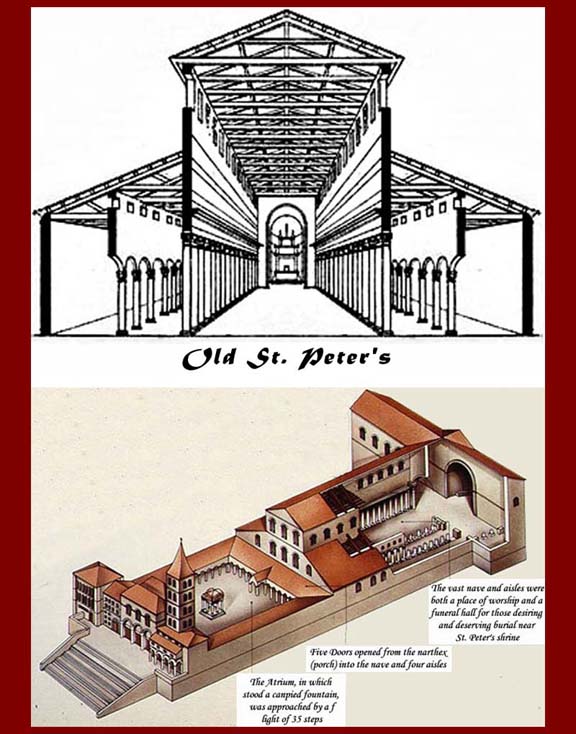
http://www.mmdtkw.org/AU0824cStPeReconst.jpg
http://www.mmdtkw.org/AU0824cStPet-Iso.jpg
Views and diagrams of Constantine's basilica of St peter. Constantine's Christian basilicas were all at the fringes of Rome either outside the Aurelian Walls or just inside the walls; almost all were martyria and were built at the site of cemeteries which were always outside the walls.
http://www.mmdtkw.org/AU0825SylvesterConstantineLegend.jpg
This enhanced image shows part of a fresco in the St. Sylvester chapel at the church of the "Quattro Coronati" (i.e., "four crowned [martyrs]") in Rome. It purports to represent the cure of Constantine's leprosy by Pope Sylvester. As a result of the supposed cure, Constantine was said to have turned over all imperial property in Rome to the Catholic church before he departed the city for Constantinople. A forged medieval document known as the Donation of Constantine was used to convince Charlemagne to renew Constantine's gift.
As early as the fifteenth century its falsity was known and demonstrated. Cardinal Nicholas of Cusa spoke of it as an apocryphal work. Later the Catholic priest Lorenzo Valla in De falso credita et ementita Constantini donatione declamatio (1440, ed. Mainz, 1518), proved the forgery with certainty -- there were both linguistic problems and historical anachronisms in the text.
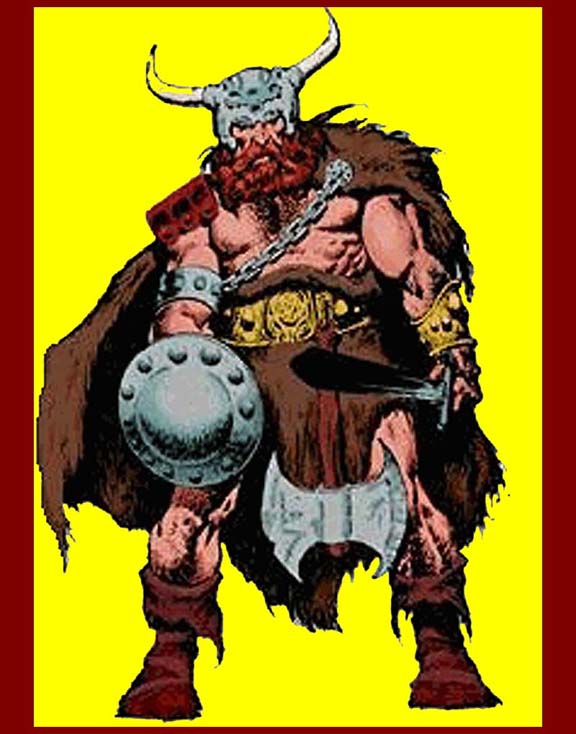
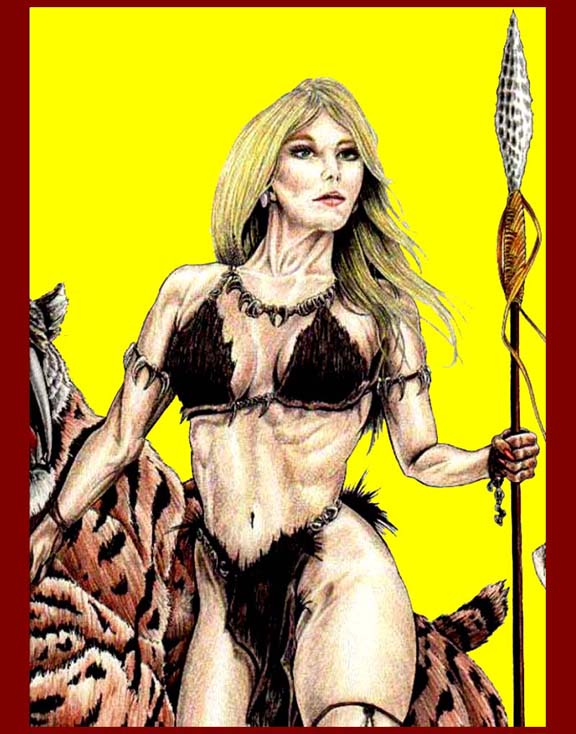

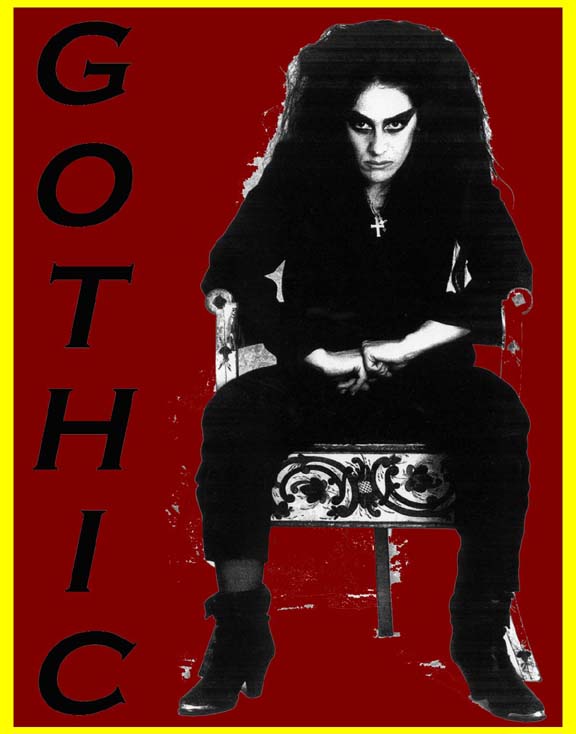
http://www.mmdtkw.org/AU0826aRobustBarbarian.jpg
http://www.mmdtkw.org/AU0826bBustyBarbarian.jpg
http://www.mmdtkw.org/AU0826cArnoldBarbarian.jpg
http://www.mmdtkw.org/AU0826dGothicBarbarian.jpg
http://www.mmdtkw.org/AU0826eooCleanBarbarian.jpg
What did barbarians look like?
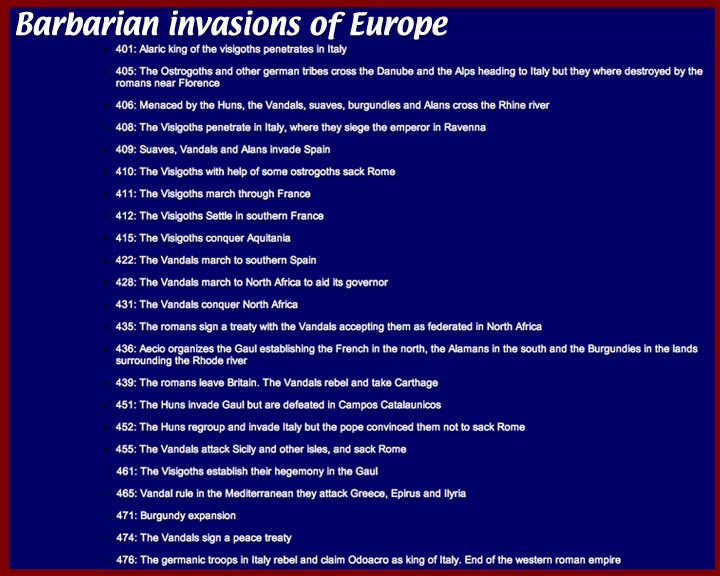
http://www.mmdtkw.org/AU0827aBarbarianInvasians1.jpg
http://www.mmdtkw.org/AU0827bBarbarianInvasians2.jpg
Here is a chronology of Barbarian activities around Europe. One theory about the mass movement/migration of peoples in Europe is based on untimely eruptions of the Krakatoa volcano. According to this theory, tribes living in central Asia had to move because their previous horse-based military advantage was lost when volcanic ash blanketed their pastures. More settled populations, including the Chinese who had built walls to keep the tribes at bay, simply chased the tribes away. When the tribes arrived in the Caucasus they quickly achieved leadership of local groups and their confederation became known as the Huns. Hun pressure then moved indigenous populations into Europe. It's still just a theory, but an interesting one. There were, of course other population pressures. Several of the barbarian groups didn't need outside pressure as a motivator. They appear simply to have been moving southward to reach better crop and pasture lands. The Vandals, for example, who ended their trek in North Africa, are thought to have originated in Scandinavia.
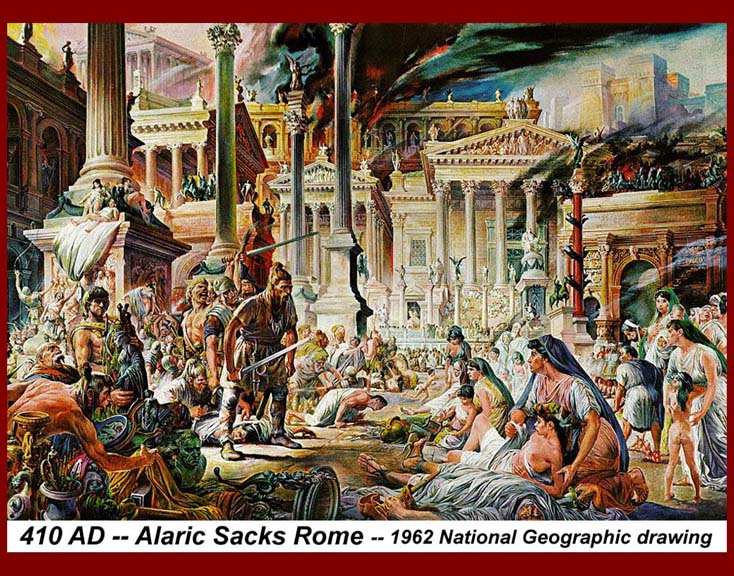
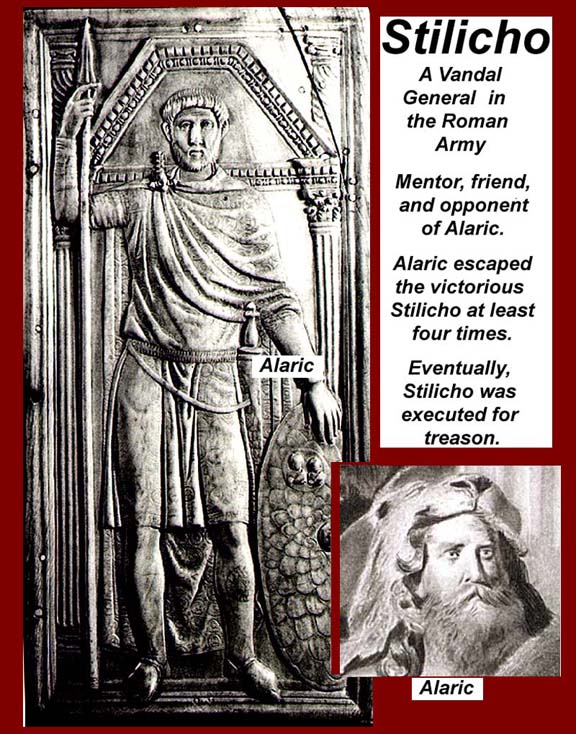
http://www.mmdtkw.org/AU0828AlaricRomeNGeog.jpg
http://www.mmdtkw.org/AU0828bStilicho.jpg
http://www.mmdtkw.org/MedRom0207GallaPlacida.jpg
Alaric was likely born about 370 on an island named Peuce ( = the Fir tree) at the mouth of the Danube. After eliminating his brother, he became king of the Visigoths in 395. He was the first Germanic leader to take the city of Rome. Having originally desired to settle his people in the Roman Empire, he finally sacked the city, marking the decline of imperial power in the west. Like other Gothic "invasions" Alaric's was actually a slow migration. When local folks tried to keep the new groups out, violence occurred. Alaric was king of the Visigoths from 395–410.For information on Alaric the Visigoth, his enemy/ally Stilicho, and the remarkable woman, Galla Placida, who was daughter of one Roman emperor, sister of another, queen of the Goths, co-founder of the Kingdom of Aquitaine, regent of the Western Roman Empire from 425 until 437 AD, and mother of yet another Roman emperor, see http://www.mmdtkw.org/VAlaric.html, and http://www.mmdtkw.org/VGallaPlacida.html.
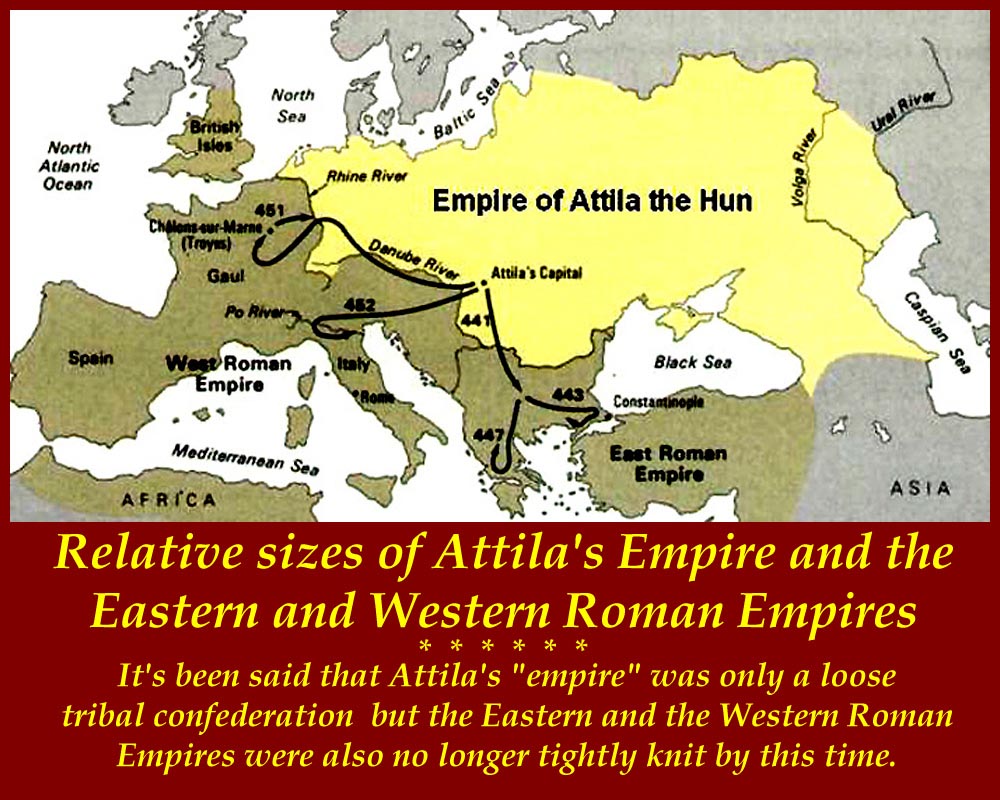
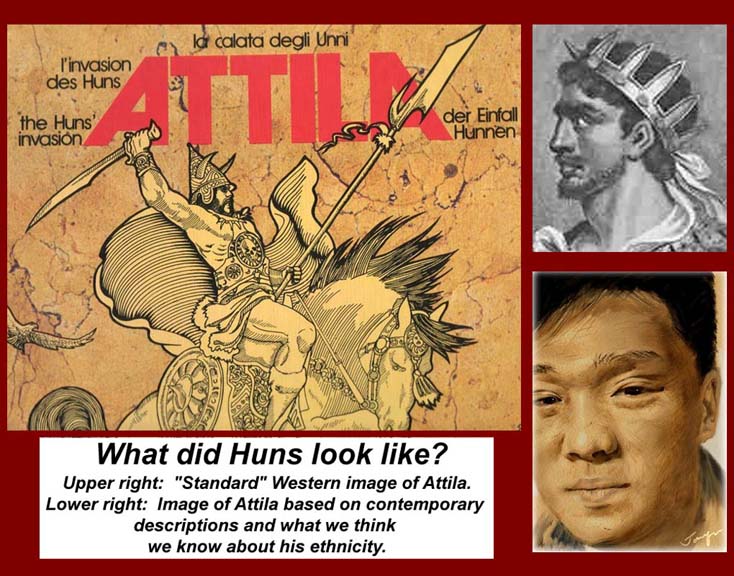
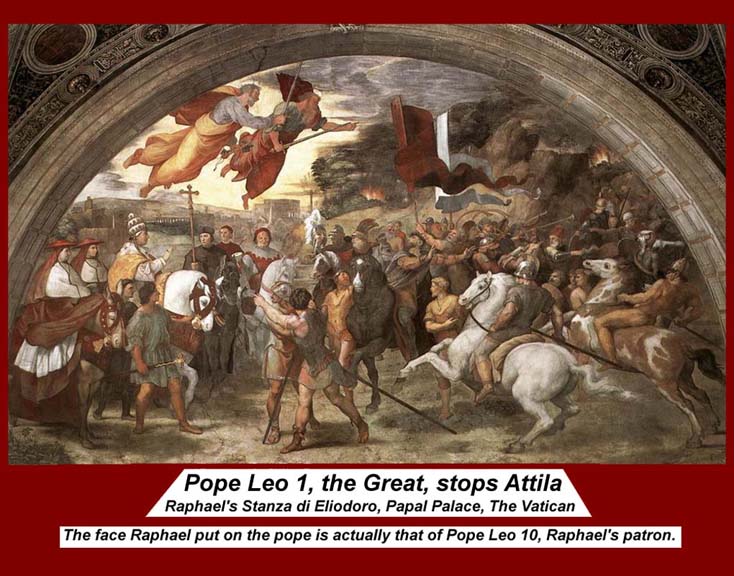
http://www.mmdtkw.org/AU0829aAttilaKingdom.jpg
http://www.mmdtkw.org/AU0829bAttilaFace.jpg
http://www.mmdtkw.org/AU0829cRaphaelAttila.jpg
http://www.mmdtkw.org/AU0829dAtillaParties.jpg
Attila (406 – 453), also known as Attila the Hun or the Scourge of God, was leader of the Huns from 434 until his death. He was leader of the Hunnic Empire which stretched from Germany to the Ural River and from the River Danube to the Baltic Sea. During his rule he was one of the most fearsome of the Western and Eastern Roman Empires' enemies: he invaded the Balkans twice, he marched through Gaul (modern France) as far as Orleans before being defeated at the Battle of Chalons. He refrained from attacking either Constantinople or Rome. His propaganda, that the Sword of Attila had come to his hand by miraculous means, was reported by the Roman Priscus.In much of Western Europe, Atilla is remembered as the epitome of cruelty and rapacity. In contrast, some histories and chronicles lionize him as a great and noble king, and he plays major roles in three Norse sagas.
We all know the story of how Atilla attacked Italy and was chased away by the Pope. It's much more complicated than that. The empire of the Huns -- actually a confederation of tribes who had allied themselves with the Huns -- was almost as large of the eastern and western Roman spheres combined (map at http://en.wikipedia.org/wiki/Image:Huns_empire.png. Galla Placida's daughter, Honoria, had communicated with Atilla and asked him to rescue her from marriage to an aged Senator. She also had sent her ring to Atilla, which he interpreted as a marriage proposal. Atilla accepted the "proposal" (even though he apparently already had several wives -- and came down to collect his bride. He demanded half of the western empire as dowry.
When the pope met Atilla in 452 AD, a Roman army was camped a few miles away, as well as Saints Peter and Paul hovering overhead. A bribe may also have been paid to Atilla. At any rate, the Huns retreated back to north of the Alps where Atilla took yet another bride to cement a local alliance. At what turned out to be his last wedding, Atilla did what Huns did: first he got drunk, then he wrestled with his best man in a mock battle for the bride, and then he fell asleep. In the wrestling match, Atilla got a nosebleed, and when he fell asleep, he drowned in his own blood. He died in 453 AD after leading the Huns for 19 years. He was 47 years old..
We don't really know who the best man was, but it could have been Atilla's "secretary/office director/chief of staff", Orestes, who was at part "Hunnish" (a German from Pavonia, which became part of the Hun federation by conquest) and may have been part "Roman" (his parents were rich and were probably Roman citizens before the Huns conquered Pavonia).
With Atilla dead, the Hunnish confederation dissolved in disputes over who would be the next leader. Orestes walked away with influence over the large Germanic part of the confederation, which, of course, included a military component. These Germanic "foederati" quietly slipped into the northern part of Italy and became a large part of the population of the area.
For more information on Atilla's adventures and misadventures, see http://en.wikipedia.org/wiki/Attila_the_Hun.
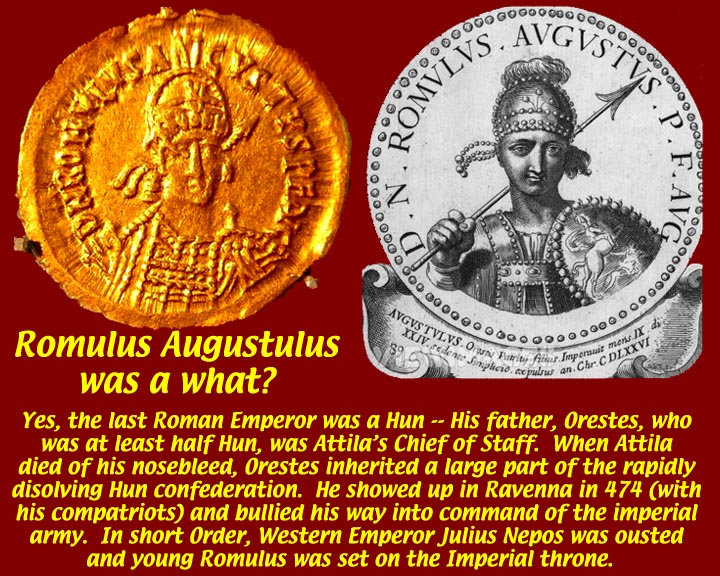
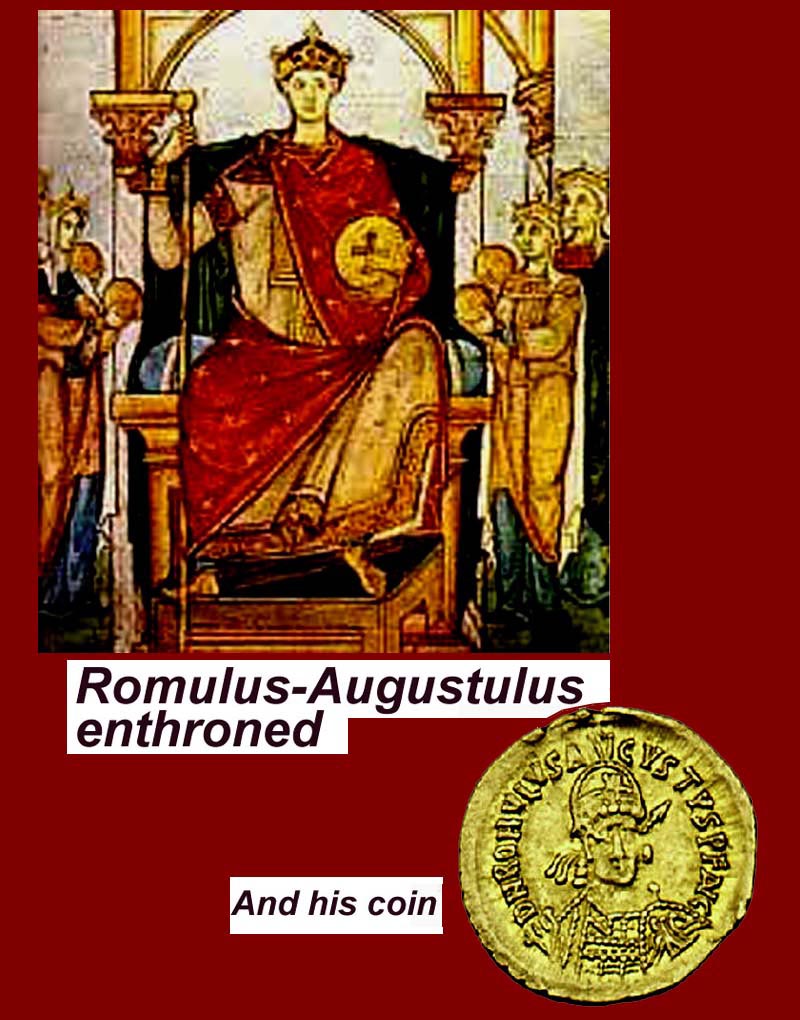
http://www.mmdtkw.org/AU0830aRomulusAugustulusHun.JPG
http://www.mmdtkw.org/AU0830bRomAugustulus.jpg
http://www.mmdtkw.org/AU0830cOdoacerReturnsRegalia.jpg
In 475, that same Orestes, who was still "patron" to the large Germanic population that had infiltrated northern Italy, was appointed magister militum (the chief of staff of the Western Empire's army) and patricius ("patrician") by Western Roman Emperor Julius Nepos. This proved to be a mistake on the part of Nepos. By August 28, 475, Orestes, at the head of the foederati (the Germanic "allies" of the Empire -- mostly Orestes' part of the former Hunnish federation) , managed to take control of the government in Ravenna, which had been the capital of the Western Roman Empire since 402. Julius Nepos fled without a fight to Dalmatia, where he would continue to "reign" until his assassination in 480. With the emperor far away, Orestes elevated his son Romulus to the rank of Augustus, so that the last Western Roman emperor is known as Romulus Augustus. So we can say that the last Roman Emperor was a Hun. He lasted a year until the arrival of Odoacer.
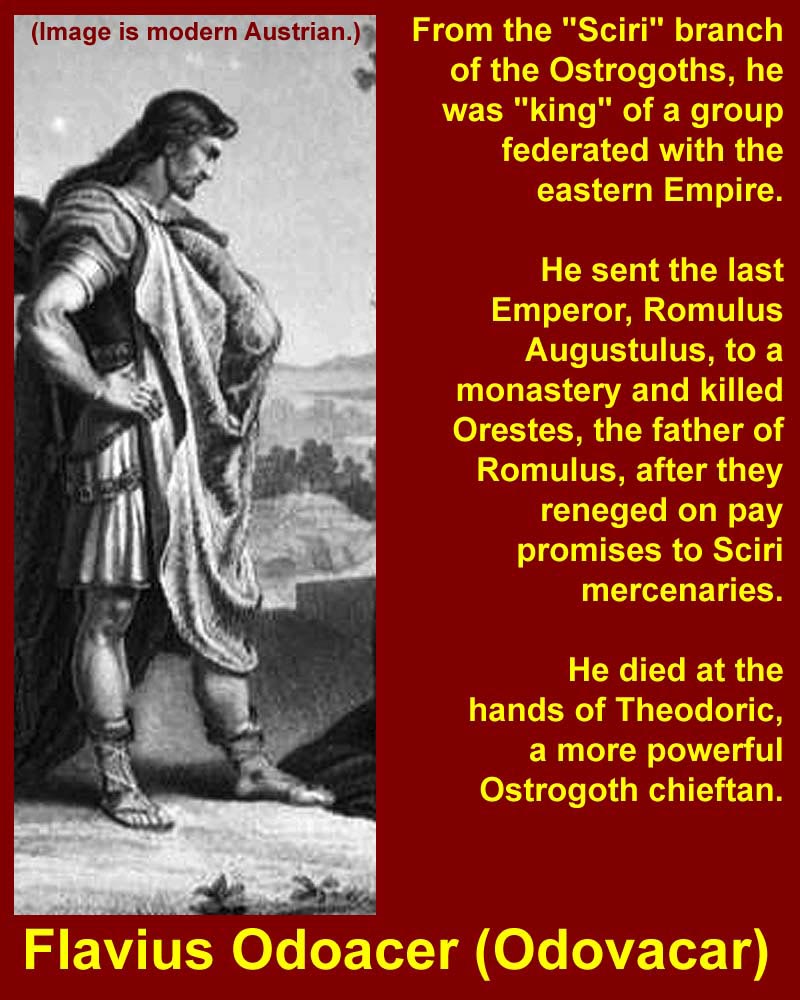
http://www.mmdtkw.org/AU0830dOdoacer.jpg
http://www.mmdtkw.org/AU0830eCastrumOvi.jpg
In 470, Odoacer had been appointed leader of a group of the Germanic foederati in northern Italy. In 475, Orestes had been appointed Magister militum and patrician by the Western Roman Emperor Julius Nepos; he was therefore head of all the Germanic foederati, including the band led by Odoacer. Orestes promised them a third of the Italic peninsula if they led the revolt against Emperor Nepos. The foederati were 30,000 strong (plus families), and they had lived on the Italic peninsula for several years at this point; however, they had only received scraps of land in relatively unfertile areas around the Apennine mountains. The foederati accepted the offer and led the revolt as planned; on August 28, 475 they defeated Nepos, who fled to Dalmatia. With the emperor far away, Orestes elevated his son Romulus to the rank of Augustus, so that the last Western Roman Emperor is known as Romulus Augustus.
After the revolt, Orestes, as magister militum, organized his own army. Behind the safety of this army, Orestes rescinded his pledge to the foederati; as a result, the foederati revolted and defeated Orestes. Odoacer was the leader of the revolt against Orestes, who was captured and executed. After the revolt, the Germanic foederati, the Scirians and the Heruli, as well as a large segment of the Italic Roman army, proclaimed Odoacer rex Italiae ("king of Italy"). In 476, Odoacer advanced to Ravenna, capturing the city and the young emperor, the son of Orestes. Romulus Augustulus was compelled to abdicate on September 4, 476. In the same year Odoacer renounced the meaningless title of Emperor, which was a wise move that avoided a conflict with Constantinople. He sent the imperial insignia to the Eastern Emperor Zeno and declared himself Patrician of the Western half, which by this time was no more than the Italian peninsula, Dalmatia and northern Gaul. The former Western Roman Emperor, Julius Nepos, "reigned" powerless in Dalmatia, where he would live until his assassination in 480. During this four-year interval Odoacer recognized Nepos as Western emperor and even made coins in his name.
In 476, Odoacer became the first Germanic King of Italy.
http://www.mmdtkw.org/AU0830fOstrogoths.jpg
From the time of their conquest by the Huns until the death of Attila, nearly a hundred years later, little is known of the Ostrogoths. It is certain that the vast majority of them remained as loyal vassals of their Hunnic overlords. They formed a significant contingent of Attila's army, and at the Battle of Châlons in 451 found themselves on the opposite side to their Visigothic cousins, who were serving as allies of Aëtius, the Roman Patrician. The Huns were defeated but it was not until Attila's death two years later that the Hunnic Empire collapsed.
In the inevitable redistribution of power, the Ostrogoths found themselves in possession of Pannonia (roughly equating to modern Hungary) as Roman federates. But with hostile neighbours on all sides and an increasing dependence on subsidies from their new masters in Constantinople, the future did not look particularly bright. That was all to be changed by Theodoric, who had spent much of his youth as yet another hostage of the East Romans, absorbing all the lessons that the Graeco-Roman civilization had to offer.The Western Empire had already fallen and Italy, at that time, was ruled by the barbarian king, Odoacer. The struggle between Theodoric and Odoacer lasted from 489 and 493, and finally ended when Theodoric murdered his rival in cold blood at a banquet. Despite claims of imperial patronage, Theodoric was not recognized as King of Italy by the eastern emperor Anastasius until 497. Theodoric ruled Italy as the self-styled "King of the Goths and Romans" until his death in 526.
But then Justinian became the emperor in the east in 527. He was set on re-establishing Roman rule in the west, and imposing religious orthodoxy on its barbarian conquerors -- most of the barbarian rulers, starting with Alaric, were the wrong kind of Christians -- Arians.
The 25-year-long series of wars between the Ostrogoths and Justinian's general, Belisarius and, later, Narses ended with the defeat and departure of the Ostrogoths. But Italy was devastated, much of the city of Rome was in ruins, and the eastern part of the empire soon lost interest in the west. This left a power vacuum that was quickly filled by the Lombards.
But that's a medieval Roman and not an ancient Roman story.
http://www.mmdtkw.org/AU0831AttilaTheHen.jpg
She's a little teapot.

